Please email your comments & questions to geovisual at comcast.net. Thank you.
Peace Monuments in South Africa


Click here for monuments in the remainder of Africa. | Click here for notable peacemakers from South Africa & Mozambique.
10 Peace Tourism Themes
(Peace Stories)
| 31 Museums for Peace
& Historic Sites
| 58 Other Peace Monuments
|
| Slavery & Emancipation
| 1666 Castle of Good Hope, Cape Town
1966 SA Cultural History Museum, Slave Lodge, Cape Town
| 1938 Slavery Emancipation Monument, Elim, Western Cape
2008 Slave Memorial, Church Square, Cape Town
2013 Emancipation 175th Anniversary Plaque, Saron Mission Church
|
Boer War
[1899-1902]
| 1902 Melrose House Museum, Vereeniging
| 1904 Honoured Dead Memorial, Kimberley
1913 National Women’s Monument, Bloemfontein
Date? Springfontein Concentration Camp Memorial
1961 Vredesmonument/Peace Monument, Vereeniging
|
| Ethnic & Cultural Diversity
| 1948 Huguenot Monument & Museum, Franschhoek
1949 Voortrekker Monument, Pretoria
1966 SA Cultural History Museum, Slave Lodge, Cape Town
1969 [Hare Krishna] Temple of Understanding, Durban
2000 South African Jewish Museum, Johannesburg
| 1939 Monument to Karle Landman, De Kol
1969 "Unity is Strength," Absa Building, Johannesburg
1975 Afrikaans Language Monument, Paarl
1995 Manyanani Peace Park,
Khayelitsha, Cape Town
2005 Maropeng Visitors Centre, Cradle of Humankind, Gauteng
2007 Statue of King Dinizulu, Botha Gardens, Durban
2007 Freedom Park, Salvokop, Pretoria
|
| Labour
| 1913 Worker's Library & Museum, Newtown, Johannesburg
| 1960 [Diamond] Diggers Memorial [Fountain], Kimberley
2011 "The Unknown Miner," University of the Witwatersrand
|
Mahatma Gandhi
[1869-1948]
| 2000 Phoenix Settlement, Bambayi, Inanda
Future Tolstoy Farm, near Johannesburg | 1993 Statue of Mahatma Gandhi, Pietermaritzburg
Date? Plaque on Pietermaritzburg railway platform
Date? Mahatma Gandhi Bust, Phoenix Settlement, Bambayi
2003 Statue of Mahatma Gandhi, Gandhi Square, Johannesburg
|
| Holocaust & Genocide
| 1999 Cape Town Holocaust Centre
2008 Johannesburg Holocaust & Genocide Centre
2009 Durban Holocaust Centre
| 1956 Mon to Martyred European Jewry, Westpark
Cem, Johannesburg
1959 Mem to the Six Million, Westpark Cemetery, Johannesburg
|
| Apartheid & Liberation
| 1916 KwaMuhle Museum, Durban
1946 John Dube’s house, Inanda
1962 Constituton Hill, Braamfontein, Johannesburg
1994 District Six Museum, Cape Town
2001 Apartheid Museum, Johannesburg
2002 Hector Pieterson Memorial & Museum, Soweto
2008 Liliesleaf Farm Museum, 7 George Avenue, Johannesburg
| 1971 Plaque of Conscience, ___ Methodist Church, Cape Town
1986 Langa Massacre Memorial, Uitenhage
1988 Terrorism Memorial, Pretoria
1989 District Six Memory Plaque, Moravian Church, Cape Town
1997 Statue of Steve Bilo, City Hall, Oxford Street, East London
1997 Bisho Massacre Memorial, Bhisho
2000 Cradock Four Memorial, Cradock
2001 Sharpeville Human Rights Precinct, Sedibeng township, Sharpeville
2005 Gugulethu Seven Monument, Gugulethu, Cape Town
2005 Freedom Charter Mon, Walter Sisulu Sq of Dedication, Kliptown
2005 Solomon Mahlangu Statue, Mamelodi, Tshwane, Pretoria
2006 Tsietsi Mashinini Memorial, Soweto, Johannesburg
2011 Gallows at Pretoria Central Prison, Pretoria
|
 Nobel Peace Prizes (Luthuli, Nobel Peace Prizes (Luthuli,
Tutu, Mandela & DeKlerk)
| 1993 Robben Island Museum, near Cape Town
1997 Nelson Mandela National Museum & House, Soweto
2000 Nelson Mandela Museum, Qunu & Mthatha
2004 Albert Luthuli Museum & House, Groutville, Natal
2013 Nelson Mandela Centre of Memory, Houghton
Future Desmond Tutu Peace Centre & Museum, Cape Town
| 1993 Albert Luthuli House (ANC Headquarters), Johannesburg
2003 Monument of Nobel Peace Prize Winners, Cape Town
2003 Nelson Mandela Bridge, Johannesburg
2004 Nelson Mandela Statue, Nelson Mandela Square, Johannesburg
2004 Albert Luthuli Statue, KwaDukuza (ex-Stanger), KwaZulu-Natal
2006 Albert Luthuli International Convention Centre, Durban
2008 Nelson Mandela Statue, Drakenstein Correctional Centre
2008? Nelson Mandela Mural, Soweto, Johannesburg
2012 Nelson Mandela Monument, Howick, KwaZulu-Natal
2013 Nelson Mandela Square, Town Hall, Stellenbosch
2013 Nelson Mandela Grave, Qunu, Eastern Cape Province
2013 Nelson Mandela Statue, Union Buildings, Pretoria
2014 Nelson Mandela "Perceiving Freedom," Sea Point, Cape Town
|
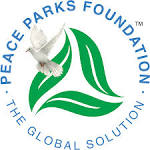 Peace Parks
/ Transfrontier Peace Parks
/ Transfrontier
Conservation Areas (TFCAs)
| 1997 Peace Parks Foundation, Stellenbosch
1997 Southern African Wildlife College, Hoedspruit, Mpumalanga
2001 SA College for Tourism, Graaff-Reinet, Eastern Cape
| Date? Administrative headquarters & main camp, Kruger NP, Skukuza
2000 Kgalagadi Transfrontier Park, South Africa/Botswana
2002 Great Limpopo Transfrontier Park (Peace Park)
2006 Greater Mapungubwe Transfrontier Conservation Area
|
| International Friendship
| Future Africa Peace Centre
| 1997 Eighth International Peace Garden, Pretoria
1999 "Non-Violence" (Knotted Gun) V&A Waterfront, Cape Town
2000 Peace Pole, Limpopo & Bela-Bela CTA, Bela-Bela
2000 South African Peace Pagoda, Barrydale
2003 World Wall for Peace, Ennerdale HS, Johannesburg
2006 O.R. Tambo International Airport, Johannesburg
2010 Peace Pole, Michael Oak School, Cape Town
Future World Peace Table, Desmond Tutu Peace Centre, Cape Town
|
Right click image to enlarge.

|
 1666 - Kasteel de Goede Hoop/Castle of Good Hope, Cape Town (South Africa). Unintentional monument. "The oldest surviving building in South Africa. Built & used to occupy slaves from 1666 onwards." /// Originally located on the coastline of Table Bay, following land reclamation the fort is now located inland. /// "As early as 1888 Mrs. Koopmans de Wet, an ardent protagonist for conservation, intervened successfully against the Imperial Government's plans to demolish Cape Town's Castle of Good Hope. In 1896, when the road skirting the Castle was to be widened for the new electric trams, she withstood demands from Prime Minister Cecil Rhodes to cut off one of the Castle's famous bastions." /// When did the castle become a intentional monument (i.e. open to the public, an historical relic, and/or memorial of colonialism and slavery)?
1666 - Kasteel de Goede Hoop/Castle of Good Hope, Cape Town (South Africa). Unintentional monument. "The oldest surviving building in South Africa. Built & used to occupy slaves from 1666 onwards." /// Originally located on the coastline of Table Bay, following land reclamation the fort is now located inland. /// "As early as 1888 Mrs. Koopmans de Wet, an ardent protagonist for conservation, intervened successfully against the Imperial Government's plans to demolish Cape Town's Castle of Good Hope. In 1896, when the road skirting the Castle was to be widened for the new electric trams, she withstood demands from Prime Minister Cecil Rhodes to cut off one of the Castle's famous bastions." /// When did the castle become a intentional monument (i.e. open to the public, an historical relic, and/or memorial of colonialism and slavery)?
|
 1879 - Anglo-Zulu War.
1879 - Anglo-Zulu War.
 1880-1881 - First Boer War (between British & Orange Free State + Transvaal Republic).
1880-1881 - First Boer War (between British & Orange Free State + Transvaal Republic).
 1899-1902 - Second Boer War (between British & Orange Free State + Transvaal Republic).
1899-1902 - Second Boer War (between British & Orange Free State + Transvaal Republic).

|
 May 31, 1902 - Melrose House Museum, 275 Jacob Mar Street, Vereeniging, Pretoria (South Africa). Across from Burger's Park. Unintentional Monument. "Melrose House was built in 1886 by Pretoria businessman George Jesse Heys. During the Anglo Boer War (1899-1902) the Melrose House was requisitioned by Lord Roberts as the headquarters for the British military, shortly after invading Pretoria in 1899. The Peace Treaty of Vereeniging was signed at Melrose House on 31 May 1902, thus ending the war.
The Victorian-style home is ornately decorated with lavish carpeting, stained glass windows & decorative ceiling panels."
May 31, 1902 - Melrose House Museum, 275 Jacob Mar Street, Vereeniging, Pretoria (South Africa). Across from Burger's Park. Unintentional Monument. "Melrose House was built in 1886 by Pretoria businessman George Jesse Heys. During the Anglo Boer War (1899-1902) the Melrose House was requisitioned by Lord Roberts as the headquarters for the British military, shortly after invading Pretoria in 1899. The Peace Treaty of Vereeniging was signed at Melrose House on 31 May 1902, thus ending the war.
The Victorian-style home is ornately decorated with lavish carpeting, stained glass windows & decorative ceiling panels."
|
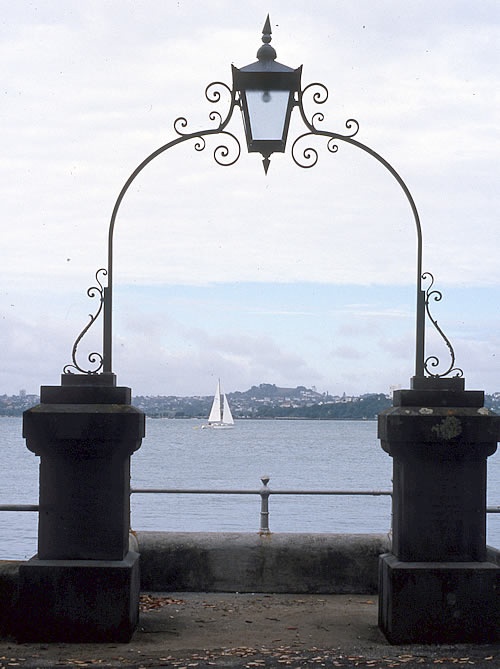 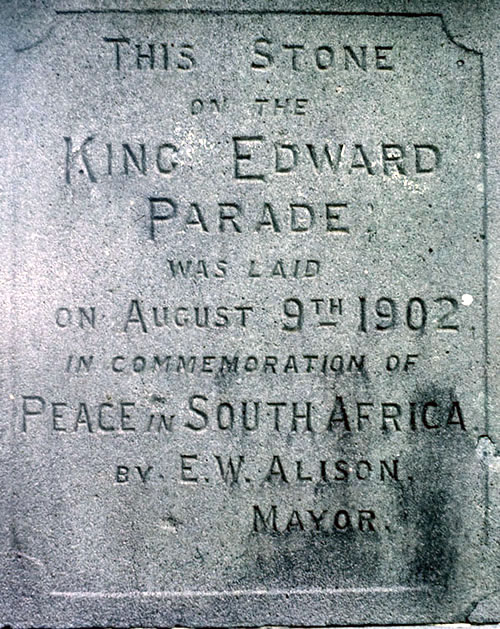

| 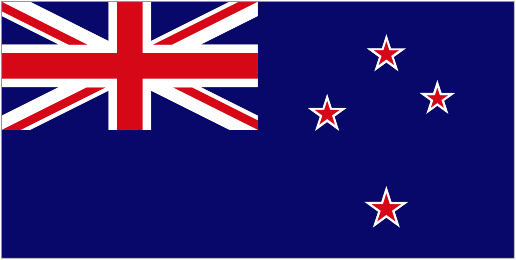 August 9, 1902 - Memorial Gate, King Edward Parade, Devonport (New Zealand). "On the seawall opposite the eastern end of Flagstaff Terrace. Topped with metal arch and a light (originally gas-powered). It also serves a dual purpose.
The right-hand pillar incorporates a stone laid on 9 August 1902 by the Mayor, E.W. Alison, to commemorate Peace in South Africa. The South African War had ended on 31 May 1902 with the Treaty of Vereeniging.
The left-hand pillar commemorates the coronation of Edward VII on 9 August 1902." August 9, 1902 - Memorial Gate, King Edward Parade, Devonport (New Zealand). "On the seawall opposite the eastern end of Flagstaff Terrace. Topped with metal arch and a light (originally gas-powered). It also serves a dual purpose.
The right-hand pillar incorporates a stone laid on 9 August 1902 by the Mayor, E.W. Alison, to commemorate Peace in South Africa. The South African War had ended on 31 May 1902 with the Treaty of Vereeniging.
The left-hand pillar commemorates the coronation of Edward VII on 9 August 1902." 
|

|
 November 28, 1904 - Honoured Dead Memorial, Kimberley (South Africa). "Commemorates those who lost their lives defending Kimberley during the 124 day siege of Kimberley at the start of the 1899-1902 Anglo Boer War. 'Long Cecil,' the gun named after Cecil Rhodes & built in the De Beers Workshops during the siege, stands on the stylobate of the monument."
November 28, 1904 - Honoured Dead Memorial, Kimberley (South Africa). "Commemorates those who lost their lives defending Kimberley during the 124 day siege of Kimberley at the start of the 1899-1902 Anglo Boer War. 'Long Cecil,' the gun named after Cecil Rhodes & built in the De Beers Workshops during the siege, stands on the stylobate of the monument."
|
 May 31, 1910 - The Union of South Africa becomes independent but remains in the
Commonwealth.
May 31, 1910 - The Union of South Africa becomes independent but remains in the
Commonwealth.



|
 1913-1976 - Worker's Library & Museum, Newtown, Johannesburg (South Africa). Unintentional monument. Newtown Workers' Electricity Compound. Last remaining example of a workers' compound in the city. To be opened next year [2014?] as a museum commemorating Joburg's municipal workers.
Consists of three semi-detached 'shiftmen's' or artisans' cottages & a stand-alone manager's house. Directly behind them are several corrugated iron shacks, housing domestic workers who worked for the artisans & manager.
And behind the shacks lies the U-shaped workmen's quarters, a red-brick, single-storey building with a wraparound veranda & courtyard...
Men used to sleep in long rows of hard concrete 'beds' next to one another, a small concrete lip separating one from the next, with no privacy." /// Right image shows "worker statue in orange overall in front of the workers' quarters, holding a spade."
1913-1976 - Worker's Library & Museum, Newtown, Johannesburg (South Africa). Unintentional monument. Newtown Workers' Electricity Compound. Last remaining example of a workers' compound in the city. To be opened next year [2014?] as a museum commemorating Joburg's municipal workers.
Consists of three semi-detached 'shiftmen's' or artisans' cottages & a stand-alone manager's house. Directly behind them are several corrugated iron shacks, housing domestic workers who worked for the artisans & manager.
And behind the shacks lies the U-shaped workmen's quarters, a red-brick, single-storey building with a wraparound veranda & courtyard...
Men used to sleep in long rows of hard concrete 'beds' next to one another, a small concrete lip separating one from the next, with no privacy." /// Right image shows "worker statue in orange overall in front of the workers' quarters, holding a spade."
|

|  December 16, 1913 - Nasionale Vrouemonument / National Women’s Monument, Bloemfontein (South Africa). "Dedicated to more than 27,000 martyr women who died in British concentration camps during the Second Boer War [1899-1902]. A 115 foot obelisk and a central bronze group of two sorrowing women & a dying child in the Springfontein camp (based on sketches by English social activist Emily Hobhouse [1860-1926] and depicting her own experience of 15 May 1901). Hobhouse's ashes were distributed here. "For 80 years the only monument in the world dedicated solely to women and children." (I wonder what monument the author of this sentence thinks came along in 1993, the Vietnam Women's Memorial in Washington, DC?) /// Sabine Marschall notes that "not a single woman was involved in the actual monument committee...." December 16, 1913 - Nasionale Vrouemonument / National Women’s Monument, Bloemfontein (South Africa). "Dedicated to more than 27,000 martyr women who died in British concentration camps during the Second Boer War [1899-1902]. A 115 foot obelisk and a central bronze group of two sorrowing women & a dying child in the Springfontein camp (based on sketches by English social activist Emily Hobhouse [1860-1926] and depicting her own experience of 15 May 1901). Hobhouse's ashes were distributed here. "For 80 years the only monument in the world dedicated solely to women and children." (I wonder what monument the author of this sentence thinks came along in 1993, the Vietnam Women's Memorial in Washington, DC?) /// Sabine Marschall notes that "not a single woman was involved in the actual monument committee...." 
|

|
 1916 - KwaMuhle Museum, 130 Bram Fischer Road, Durban (South Africa). Unintentional monument. "Former premises of Durban's notorious Native Affairs Department. The Department was established in 1916, with John Sydney Marwick as its first manager. Marwick was given the name 'uMuhle' because he successfully repatriated about seven thousand Zulus back to Zululand prior to the onset of the South African War (1899-1902). ///
In the mid 1990's the building was converted into a museum. The rooms in the newly established museum have names closely associated with the history of the Native Affairs Department. The Bourquin Boardroom is located next to the Mafukuzela Library. Mafukuzela was the nickname given to John Langalibalele Dube [1871-1946], first President of the South African National Congress, while S. B. Bourquin [1915-2004] was, for two decades, the Director of the Department of Bantu Administration...'
1916 - KwaMuhle Museum, 130 Bram Fischer Road, Durban (South Africa). Unintentional monument. "Former premises of Durban's notorious Native Affairs Department. The Department was established in 1916, with John Sydney Marwick as its first manager. Marwick was given the name 'uMuhle' because he successfully repatriated about seven thousand Zulus back to Zululand prior to the onset of the South African War (1899-1902). ///
In the mid 1990's the building was converted into a museum. The rooms in the newly established museum have names closely associated with the history of the Native Affairs Department. The Bourquin Boardroom is located next to the Mafukuzela Library. Mafukuzela was the nickname given to John Langalibalele Dube [1871-1946], first President of the South African National Congress, while S. B. Bourquin [1915-2004] was, for two decades, the Director of the Department of Bantu Administration...'
|
 July 18, 1918 - Birth of Nelson Mandela in Mvezo, Cape Province.
July 18, 1918 - Birth of Nelson Mandela in Mvezo, Cape Province.
 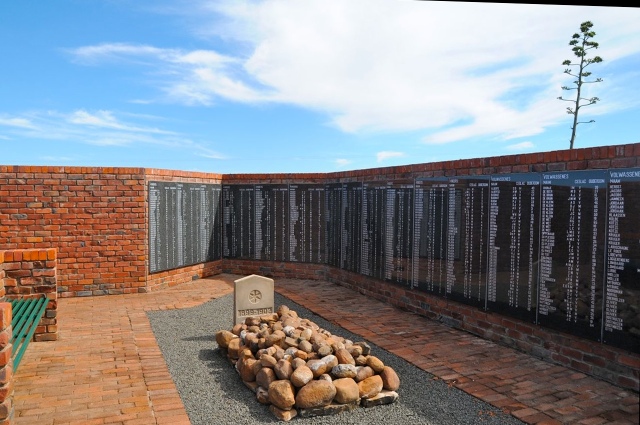
 |  Date? - Springfontein Concentration Camp Memorial, Springfontein, Orange Free State (South Afica). "During the Second Boer War/Anglo-Boer War, 568 people of all ages are recorded in the Springfontein Grave Register as having died there between 4 April & the end of 1901. Their graves can be seen in the concentration camp cemetery. During the war, the camp was visited by Emily Hobhouse during her investigations of conditions in the camps." /// Right image shows "wall of remembrance for the women & children who died in the concentration camps & whose farms had been destroyed and burned down as part of the scorched earth policy to bring the Boer forces to surrender." /// Click here for more about the concentration camps. Date? - Springfontein Concentration Camp Memorial, Springfontein, Orange Free State (South Afica). "During the Second Boer War/Anglo-Boer War, 568 people of all ages are recorded in the Springfontein Grave Register as having died there between 4 April & the end of 1901. Their graves can be seen in the concentration camp cemetery. During the war, the camp was visited by Emily Hobhouse during her investigations of conditions in the camps." /// Right image shows "wall of remembrance for the women & children who died in the concentration camps & whose farms had been destroyed and burned down as part of the scorched earth policy to bring the Boer forces to surrender." /// Click here for more about the concentration camps.
|
 
 |  July 19, 1919 - Pax Memorial, Walmer Golf Course, 10th Avenue, Port Elizabeth (South Africa). "Six metre cement obelisk Celebrates the outbreak of peace. Inscribed with the Word PAX (Peace) & the date 1918. Unveiled at a lavish bonfire & celebration. [But] over time the monument became forgotten & merged with the trees & undergrowth. Renewed interest in 1982 did not result in the memorial being moved, & once again it disappeared into obscurity. Today it is probably only ever seen by golfers playing their obligatory 9 holes." July 19, 1919 - Pax Memorial, Walmer Golf Course, 10th Avenue, Port Elizabeth (South Africa). "Six metre cement obelisk Celebrates the outbreak of peace. Inscribed with the Word PAX (Peace) & the date 1918. Unveiled at a lavish bonfire & celebration. [But] over time the monument became forgotten & merged with the trees & undergrowth. Renewed interest in 1982 did not result in the memorial being moved, & once again it disappeared into obscurity. Today it is probably only ever seen by golfers playing their obligatory 9 holes."
|

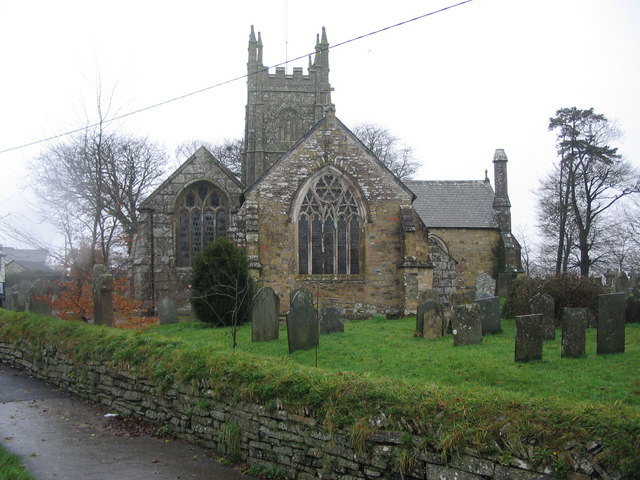

|  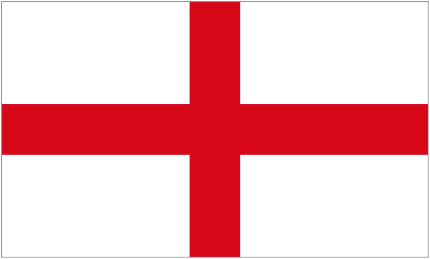 About 1930? - Statue of Emily Hobhouse, Parish Church, St. Ive, Cornwall (England). There are many memorials for social activist & Second Boer War relief worker Emily Hobhouse [1860-1926]. Click for
bust,
plaque (June 8, 1994),
scenic lounge,
hotel suite,
street, and
old age home. Also see the 1913 National Women's Monument in Bloemfontein (South Africa) where her ashes are distributed.
She & her brother, liberal politician Leonard Trelawny Hobhouse [1864-1929], were both born in St Ive. Photo taken 26 January 2010 courtesy of Lisa Heeley, Paddy Long & Gerard Lössbroek. About 1930? - Statue of Emily Hobhouse, Parish Church, St. Ive, Cornwall (England). There are many memorials for social activist & Second Boer War relief worker Emily Hobhouse [1860-1926]. Click for
bust,
plaque (June 8, 1994),
scenic lounge,
hotel suite,
street, and
old age home. Also see the 1913 National Women's Monument in Bloemfontein (South Africa) where her ashes are distributed.
She & her brother, liberal politician Leonard Trelawny Hobhouse [1864-1929], were both born in St Ive. Photo taken 26 January 2010 courtesy of Lisa Heeley, Paddy Long & Gerard Lössbroek. 
|
 - N.B.: "The southernmost town in Eastern Free State is named Hobhouse, after Emily Hobhouse, as was a submarine: the SAS Emily Hobhouse, one of the South African Navy's three Daphné class submarines. In 1994, after the end of minority rule, the submarine was renamed the SAS Umkhonto."
- N.B.: "The southernmost town in Eastern Free State is named Hobhouse, after Emily Hobhouse, as was a submarine: the SAS Emily Hobhouse, one of the South African Navy's three Daphné class submarines. In 1994, after the end of minority rule, the submarine was renamed the SAS Umkhonto."


|
 1938 - Slavery Emancipation Monument, Elim, Western Cape (South AFrica). "Elim – which means ‘place of rest’ & is a biblical reference to the Israelites – is unusual in several ways. It’s a town wholly owned by the church & is a national monument in its entirety. Established as a Morovian mission station in 1824 by Bishop Hallbeck, the entire town is registered as a farm belonging to the Morovian church. All inhabitants are members of the church. When slavery was abolished in 1834 in the Cape, many freed slaves came to live here, and in 1938 a memorial to the emancipation of slaves was erected. It is the only such monument in South Africa."
1938 - Slavery Emancipation Monument, Elim, Western Cape (South AFrica). "Elim – which means ‘place of rest’ & is a biblical reference to the Israelites – is unusual in several ways. It’s a town wholly owned by the church & is a national monument in its entirety. Established as a Morovian mission station in 1824 by Bishop Hallbeck, the entire town is registered as a farm belonging to the Morovian church. All inhabitants are members of the church. When slavery was abolished in 1834 in the Cape, many freed slaves came to live here, and in 1938 a memorial to the emancipation of slaves was erected. It is the only such monument in South Africa."
|

|
 December 16, 1939 -
Monument to Karle Landman,
De Kol, Cape (South Africa). Designed by G. Moerdijk. Karle Landman was a leader of the Voortrekkers. Note ten oxen pulling a Voortrekker wagon across South Africa on the globe.
December 16, 1939 -
Monument to Karle Landman,
De Kol, Cape (South Africa). Designed by G. Moerdijk. Karle Landman was a leader of the Voortrekkers. Note ten oxen pulling a Voortrekker wagon across South Africa on the globe.
|

|
 1946 - John Dube’s house, Inanda (South Africa). Unintentional monument. John Langalibalele Dube [1871-1946] was an essayist, philosopher, educator, politician, publisher, editor, novelist & poet. He founded the South African Native National Congress (SANNC), which became the African National Congress (ANC) in 1923.. /// "On a recent trip to Inanda, I was amazed at the state of disrepair of some of the heritage buildings there, in particular John Dube’s house. The roof is falling down and was meant to be repaired (by ‘government’) two years ago, when the family were moved into temporary accommodation on the property. Other buildings which are in desperate need of restoring, & would add value to the burgeoning tourism industry in Inanda, are the iron & wood structures in the Gumede family homestead. These buildings housed the first doctor’s surgery & post office in the area." /// "The modest homes of several struggle icons have been preserved and turned into a museum. This includes the Mandela residence in Soweto, Albert Luthuli’s house in Groutville, or John Dube’s house in Inanda. [Sabine Marschall]"
1946 - John Dube’s house, Inanda (South Africa). Unintentional monument. John Langalibalele Dube [1871-1946] was an essayist, philosopher, educator, politician, publisher, editor, novelist & poet. He founded the South African Native National Congress (SANNC), which became the African National Congress (ANC) in 1923.. /// "On a recent trip to Inanda, I was amazed at the state of disrepair of some of the heritage buildings there, in particular John Dube’s house. The roof is falling down and was meant to be repaired (by ‘government’) two years ago, when the family were moved into temporary accommodation on the property. Other buildings which are in desperate need of restoring, & would add value to the burgeoning tourism industry in Inanda, are the iron & wood structures in the Gumede family homestead. These buildings housed the first doctor’s surgery & post office in the area." /// "The modest homes of several struggle icons have been preserved and turned into a museum. This includes the Mandela residence in Soweto, Albert Luthuli’s house in Groutville, or John Dube’s house in Inanda. [Sabine Marschall]"
|



|
 April 17, 1948 - Huguenot Monument & Museum, Franschhoek (South Africa). "Dedicated to the cultural influences that Huguenots have brought to the Cape Colony (and ultimately the whole of South Africa) after their immigration during the 17th & 18th centuries. The monument was designed by J.C. Jongens, completed in 1945 and inaugurated by Dr. A.J van der Merwe on April 17, 1948."
April 17, 1948 - Huguenot Monument & Museum, Franschhoek (South Africa). "Dedicated to the cultural influences that Huguenots have brought to the Cape Colony (and ultimately the whole of South Africa) after their immigration during the 17th & 18th centuries. The monument was designed by J.C. Jongens, completed in 1945 and inaugurated by Dr. A.J van der Merwe on April 17, 1948."
|
 1948 - Apartheid system created after general election.
1948 - Apartheid system created after general election.

|
 December 16, 1949 - Voortrekker Monument, outside of Pretoria (South Africa). "...to the Afrikaner expansion of the 1830's known as the Great Trek when the pioneers trekked from the western Cape Colony east across the vast Great Karoo in order to escape British domination. (NB: They prefer the word 'expansion' rather than 'migration.' There [is] a display in the museum explaining the difference.) Eventually they established a separate Afrikaner nation in the Transvaal with Pretoria as its capital.
The Voortrekker Monument itself is massive. It houses a Museum, a Hall of Heroes and historical timeline Frieze, and the great Cenotaph Hall. The Monument sits high atop a mountain protected by a symbolic Laager (or wagon train) Frieze Wall against a Zulu spear fence. You can see it for miles. The monument was built on the grounds of an old fort Schanskop & still has the old (1897) fort to explore along with a new (2008) Afrikaner Heritage Center."
December 16, 1949 - Voortrekker Monument, outside of Pretoria (South Africa). "...to the Afrikaner expansion of the 1830's known as the Great Trek when the pioneers trekked from the western Cape Colony east across the vast Great Karoo in order to escape British domination. (NB: They prefer the word 'expansion' rather than 'migration.' There [is] a display in the museum explaining the difference.) Eventually they established a separate Afrikaner nation in the Transvaal with Pretoria as its capital.
The Voortrekker Monument itself is massive. It houses a Museum, a Hall of Heroes and historical timeline Frieze, and the great Cenotaph Hall. The Monument sits high atop a mountain protected by a symbolic Laager (or wagon train) Frieze Wall against a Zulu spear fence. You can see it for miles. The monument was built on the grounds of an old fort Schanskop & still has the old (1897) fort to explore along with a new (2008) Afrikaner Heritage Center."
|
 June 26, 1955 - Freedom Charter, Congress of the People, Kliptown, Soweto.
June 26, 1955 - Freedom Charter, Congress of the People, Kliptown, Soweto.
 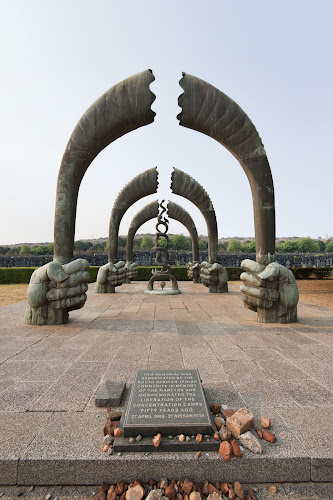

|
 1959 - Memorial to the Six Million, Westpark Cemetery, Johannesburg (South Africa). By Herman Wald. "Bronze - 5.1m high. Depicts six mighty bronze fists, each five feet high, bursting out of the ground as a protest of the dead, each fist representing one million Jews who perished under Hitler, and each gripping a ram's horn, the Jewish ritual trumpet standing twenty feet high. In pairs they create three arches; the arches of trials and tribulations that the Jewish people have all gone through during all the generations of persecution. In the centre there is a flame shaped Eternal Light, spiralling fifteen feet up. Through the ram's horns the Dead are blasting out the Sixth Commandment: 'Though shalt not kill,' while the centre eternal light is stylized through the medium of the Hebrew lettering, to form a flame which spells in Hebrew 'Lo Tirtzach (Thou Shalt Not Kill)'."
1959 - Memorial to the Six Million, Westpark Cemetery, Johannesburg (South Africa). By Herman Wald. "Bronze - 5.1m high. Depicts six mighty bronze fists, each five feet high, bursting out of the ground as a protest of the dead, each fist representing one million Jews who perished under Hitler, and each gripping a ram's horn, the Jewish ritual trumpet standing twenty feet high. In pairs they create three arches; the arches of trials and tribulations that the Jewish people have all gone through during all the generations of persecution. In the centre there is a flame shaped Eternal Light, spiralling fifteen feet up. Through the ram's horns the Dead are blasting out the Sixth Commandment: 'Though shalt not kill,' while the centre eternal light is stylized through the medium of the Hebrew lettering, to form a flame which spells in Hebrew 'Lo Tirtzach (Thou Shalt Not Kill)'."
|
 March 21, 1960 - Sharpville Massacre.
March 21, 1960 - Sharpville Massacre.
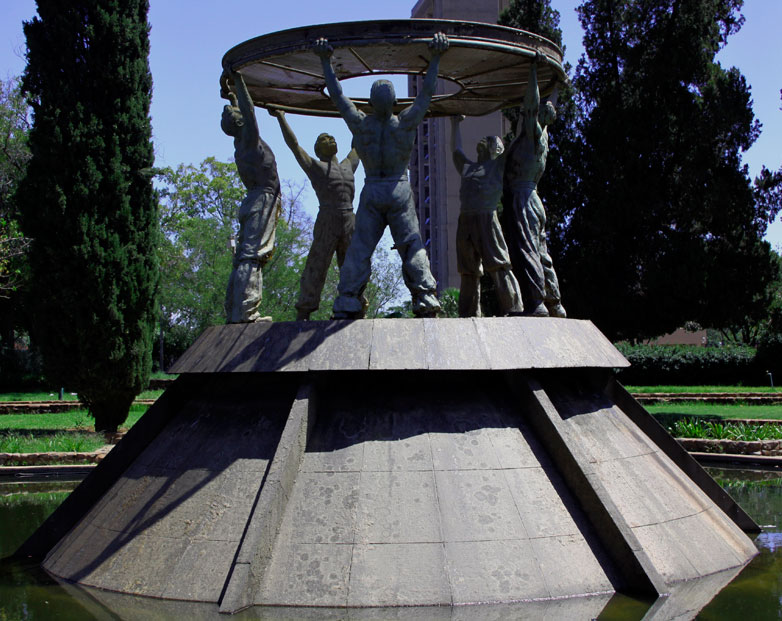


|
 1960 - [Diamond] Diggers Memorial [Fountain], Ernest Oppenheimer Gardens, Kimberley (South Africa). By Herman Wald [1906-1970]. "Erected in honour of diggers past & present. The gardens are a memorial to mining magnate Sir Ernest Oppenheimer [1880-1957]. He was the first mayor of Kimberley when Beaconsfield & Kimberley were combined into a city in 1912."
1960 - [Diamond] Diggers Memorial [Fountain], Ernest Oppenheimer Gardens, Kimberley (South Africa). By Herman Wald [1906-1970]. "Erected in honour of diggers past & present. The gardens are a memorial to mining magnate Sir Ernest Oppenheimer [1880-1957]. He was the first mayor of Kimberley when Beaconsfield & Kimberley were combined into a city in 1912."
|
 May 31, 1961 - South Africa becomes a Republic following a referendum.
May 31, 1961 - South Africa becomes a Republic following a referendum.

|  May 31, 1961 - Vredesmonument/Peace Monument, Melrose House, Vereeniging, Vaal Triangle, Gauteng province (South Africa). Dedicated October 10, 1961? "Honors all who fought & all who died during the Anglo-Boer War [1899-1902]. "Coert Steynberg [1905-1982], famed SA artist, was commissioned to design a monument honoring all who fought and all who lost their lives for peace during the Anglo-Boer War. The motto "Gewond maar nie onoorwonne" (Wounded but Not Defeated) enbodies the fighting spirit of the Boer Nation after surrendering to the British. This motto is still significant today as it represents the character, courage and spirit of reconciliation of the New South African Nation.Unveiled by the then Prime Minister, Dr. H.F. Verwoerd. Vereeniging was chosen as the site for the monument because the peace negotiations that ultimately ended the war took place in Vereeniging." /// "Symbolizes the spiritual revival of a vanquished people. It is in the form of a fatally wounded soldier from farmers whose heart the spirit of hope, faith and power up rice to an insured due. The leaning figure, in light granite with a staaldolk in his heart, resting on a heavy base. The spirit, which only outlines proposed where it wound up rice, spot free of steel and symboliseer and mental purification through intense suffering unbreakable strength. Steyn Store monument as one of his best works considered, the extraordinary abstract and unusual symbolism major disagreement caused, which, in many of his subsequent public commissions returned to a more recognizable representation that easily by the public understand could. [Google translation]" May 31, 1961 - Vredesmonument/Peace Monument, Melrose House, Vereeniging, Vaal Triangle, Gauteng province (South Africa). Dedicated October 10, 1961? "Honors all who fought & all who died during the Anglo-Boer War [1899-1902]. "Coert Steynberg [1905-1982], famed SA artist, was commissioned to design a monument honoring all who fought and all who lost their lives for peace during the Anglo-Boer War. The motto "Gewond maar nie onoorwonne" (Wounded but Not Defeated) enbodies the fighting spirit of the Boer Nation after surrendering to the British. This motto is still significant today as it represents the character, courage and spirit of reconciliation of the New South African Nation.Unveiled by the then Prime Minister, Dr. H.F. Verwoerd. Vereeniging was chosen as the site for the monument because the peace negotiations that ultimately ended the war took place in Vereeniging." /// "Symbolizes the spiritual revival of a vanquished people. It is in the form of a fatally wounded soldier from farmers whose heart the spirit of hope, faith and power up rice to an insured due. The leaning figure, in light granite with a staaldolk in his heart, resting on a heavy base. The spirit, which only outlines proposed where it wound up rice, spot free of steel and symboliseer and mental purification through intense suffering unbreakable strength. Steyn Store monument as one of his best works considered, the extraordinary abstract and unusual symbolism major disagreement caused, which, in many of his subsequent public commissions returned to a more recognizable representation that easily by the public understand could. [Google translation]"
|



|
 1961 - Nelson Mandela National Museum, 8115 Vilakazi Street, Orlando, Soweto, Johannesburg (South Africa). Unintentional monument. "Nelson Mandela's first house [from 1946]. Not surprisingly a popular tourist attraction. Mandela stayed here with his then wife, Winnie, before he was imprisoned in 1961 and jailed for 27 years. The house is now a museum, run by Winnie Madikizela-Mandela, & contains memorabilia from the short time they lived there together before Mandela went into hiding." /// "Mandela returned to the house after his release from prison in 1990, despite suggestions from government officials that he find a safer home... However, after 11 days back at the house he moved out again... He donated the house to the Soweto Heritage Trust (of which he was the founder) on 1 September 1997, to be run as a museum." In 1999, Soweto was the 16th most popular place for tourists to South Africa to visit, and that was partly ascribed to the opening of Mandela House in December 1997."
1961 - Nelson Mandela National Museum, 8115 Vilakazi Street, Orlando, Soweto, Johannesburg (South Africa). Unintentional monument. "Nelson Mandela's first house [from 1946]. Not surprisingly a popular tourist attraction. Mandela stayed here with his then wife, Winnie, before he was imprisoned in 1961 and jailed for 27 years. The house is now a museum, run by Winnie Madikizela-Mandela, & contains memorabilia from the short time they lived there together before Mandela went into hiding." /// "Mandela returned to the house after his release from prison in 1990, despite suggestions from government officials that he find a safer home... However, after 11 days back at the house he moved out again... He donated the house to the Soweto Heritage Trust (of which he was the founder) on 1 September 1997, to be run as a museum." In 1999, Soweto was the 16th most popular place for tourists to South Africa to visit, and that was partly ascribed to the opening of Mandela House in December 1997."
|
 August 5, 1962 - Police capture Nelson Mandela leading to his trial & emprisonment on Robben Island.
August 5, 1962 - Police capture Nelson Mandela leading to his trial & emprisonment on Robben Island.
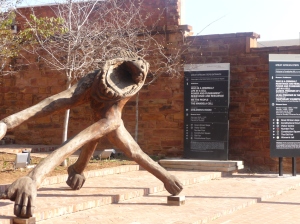 

|
 August 5, 1962 - Constitution Hill, 11 Kotze Street, Braamfontein, Johannesburg (South Africa). Unintentional Monument. "Formerly the site of a fort which was later used as a prison. The Old Fort Prison complex is known as Number Four. The original prison was built to house white male prisoners in 1892. The Old Fort was built around this prison by Paul Kruger from 1896 to 1899 to protect the South African Republic from the threat of British invasion. Later, Boer military leaders of the Anglo-Boer War were imprisoned here by the British.
The Old Fort prison was later extended to include "native" cells, called Section 4 and Section 5, and, in 1907, a women's section was added. An awaiting-trial block was constructed in the 1920's. Both political activists opposed to apartheid & common criminals were held at the prison. Mahatma Gandhi was imprisoned here in 1906, and striking white mineworkers in 1907, 1913 and 1922.
Under the apartheid government, only whites were held in the Old Fort itself, except for Nelson Mandela, who was given a bed in the hospital section when he was as an awaiting-trial prisoner in 1962 prior to the Rivonia Trial. Joe Slovo, Bram Fischer, Albert Luthuli and Robert Sobukwe were also inmates." /// "Heritage sites such as Robben Island & Constitution Hill represent the suffering of those who fought for freedom, while at the same time serving as symbols of triumph over adversity.
New heroes are being worshipped in post-apartheid monuments. [Sabine Marschall]"
August 5, 1962 - Constitution Hill, 11 Kotze Street, Braamfontein, Johannesburg (South Africa). Unintentional Monument. "Formerly the site of a fort which was later used as a prison. The Old Fort Prison complex is known as Number Four. The original prison was built to house white male prisoners in 1892. The Old Fort was built around this prison by Paul Kruger from 1896 to 1899 to protect the South African Republic from the threat of British invasion. Later, Boer military leaders of the Anglo-Boer War were imprisoned here by the British.
The Old Fort prison was later extended to include "native" cells, called Section 4 and Section 5, and, in 1907, a women's section was added. An awaiting-trial block was constructed in the 1920's. Both political activists opposed to apartheid & common criminals were held at the prison. Mahatma Gandhi was imprisoned here in 1906, and striking white mineworkers in 1907, 1913 and 1922.
Under the apartheid government, only whites were held in the Old Fort itself, except for Nelson Mandela, who was given a bed in the hospital section when he was as an awaiting-trial prisoner in 1962 prior to the Rivonia Trial. Joe Slovo, Bram Fischer, Albert Luthuli and Robert Sobukwe were also inmates." /// "Heritage sites such as Robben Island & Constitution Hill represent the suffering of those who fought for freedom, while at the same time serving as symbols of triumph over adversity.
New heroes are being worshipped in post-apartheid monuments. [Sabine Marschall]"
|
 1963-1964 - Rivonia Treason Trial.
1963-1964 - Rivonia Treason Trial.

|  1966 - South African Cultural History Museum, Adderley Street (the old Heerengracht), Cape Town (South Africa). Occupies former Slave Lodge completed in 1679 by the Dutch East India Company (Vereenigde Oost-Indische Compagnie or VOC in Dutch). Housed as many as 1,000 slaves. Converted to government offices in 1806 by the British. Now part of Iziko Museums of Cape Town. 1966 - South African Cultural History Museum, Adderley Street (the old Heerengracht), Cape Town (South Africa). Occupies former Slave Lodge completed in 1679 by the Dutch East India Company (Vereenigde Oost-Indische Compagnie or VOC in Dutch). Housed as many as 1,000 slaves. Converted to government offices in 1806 by the British. Now part of Iziko Museums of Cape Town.
|
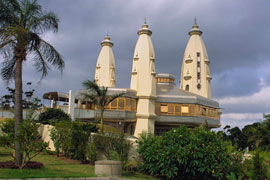
|
 1969 - Temple of Understanding, Chatsworth, Durban (South Africa). On the Inanda Heritage Trail. "Also known as the Sri Radhanath Temple of Understanding. One of the most visited attractions in Durban. Said to be the largest Hare Krishna temple in Africa, and is an awe inspiring marvel of India's ancient cultural heritage; acclaimed as an architectural masterpiece & African landmark. Built in the shape of a Lotus. Magnificent gardens [followed in 1975]."
1969 - Temple of Understanding, Chatsworth, Durban (South Africa). On the Inanda Heritage Trail. "Also known as the Sri Radhanath Temple of Understanding. One of the most visited attractions in Durban. Said to be the largest Hare Krishna temple in Africa, and is an awe inspiring marvel of India's ancient cultural heritage; acclaimed as an architectural masterpiece & African landmark. Built in the shape of a Lotus. Magnificent gardens [followed in 1975]."

|
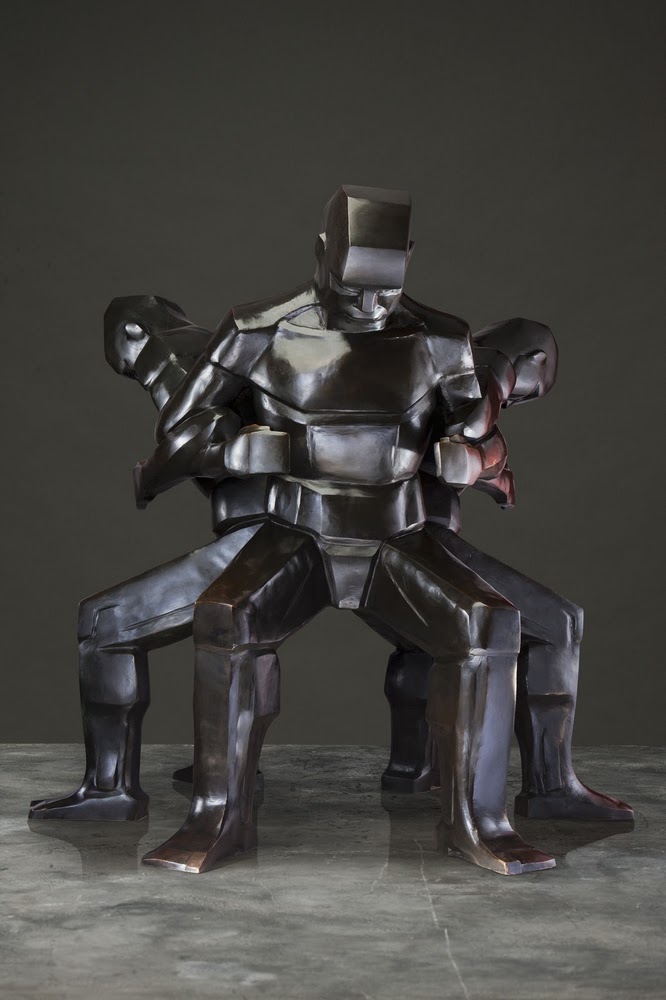
|
 1969 - "Unity is Strength," Absa Building, Main Street, Johannesburg (South Africa). By Herman Wald [1906-1970]. 1.5x life size bronze. Originally commissioned by the United Building Society. The use of emphatically varied facial feature types was a strong plea for unity amongst equality for all South Africans.
1969 - "Unity is Strength," Absa Building, Main Street, Johannesburg (South Africa). By Herman Wald [1906-1970]. 1.5x life size bronze. Originally commissioned by the United Building Society. The use of emphatically varied facial feature types was a strong plea for unity amongst equality for all South Africans.
|
 
 | 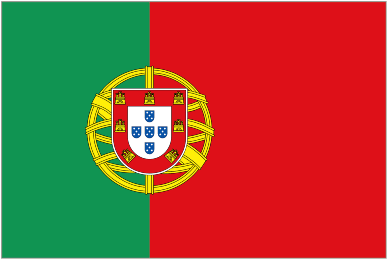 1970 - "ANC Liberty March against Apartheid," Monte Palace Tropical Garden, Funchal, Autonomous Region of Madeira (Portugal). "A [bronze] statue by Hungarian sculptor Zoltan Borbereki [1907-1992] commemorates the involvement of the African National Congress (ANC) in the struggle against South African apartheid. Credit: Creative Commons/Allie Caulfield/Zoltan Borbereki." Information courtesy of Tikkun Magazine, Summer 2015. 1970 - "ANC Liberty March against Apartheid," Monte Palace Tropical Garden, Funchal, Autonomous Region of Madeira (Portugal). "A [bronze] statue by Hungarian sculptor Zoltan Borbereki [1907-1992] commemorates the involvement of the African National Congress (ANC) in the struggle against South African apartheid. Credit: Creative Commons/Allie Caulfield/Zoltan Borbereki." Information courtesy of Tikkun Magazine, Summer 2015. 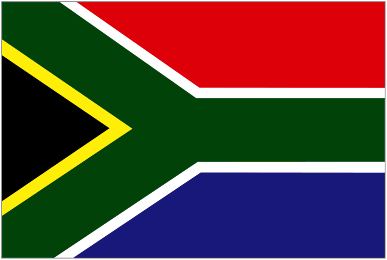
|


|
 1971 - Plaque of Conscience, ____ Methodist Church, District Six, Cape Town (South Africa).
"The first monument in South Africa to the victims of apartheid. It was put up, torn down by the police, and put up again." Text:
"ALL WHO PASS BY /
Remember with shame the many thousands /
of people who lived for generations /
in District Six and other parts of / this city,
and were forced by law to / leave their homes
because of the / colour of their skins. /
FATHER, FORGIVE US ..."
1971 - Plaque of Conscience, ____ Methodist Church, District Six, Cape Town (South Africa).
"The first monument in South Africa to the victims of apartheid. It was put up, torn down by the police, and put up again." Text:
"ALL WHO PASS BY /
Remember with shame the many thousands /
of people who lived for generations /
in District Six and other parts of / this city,
and were forced by law to / leave their homes
because of the / colour of their skins. /
FATHER, FORGIVE US ..."
|


|
 February 11, 1989 - District Six Memory Plaque, Moravian Church, District Six, Cape Town (South Africa).
Text: "ALL WHO PASS / Remember the thousands of people who lived / for generations in District Six / and were forced by laws to leave their homes / because of the colour of their skins. / Remember St. Mark's [Anglican] Church and the community / who reisisted the destruction of District Six. / Hands Off District Six Campaign, 11.2.1989."
February 11, 1989 - District Six Memory Plaque, Moravian Church, District Six, Cape Town (South Africa).
Text: "ALL WHO PASS / Remember the thousands of people who lived / for generations in District Six / and were forced by laws to leave their homes / because of the colour of their skins. / Remember St. Mark's [Anglican] Church and the community / who reisisted the destruction of District Six. / Hands Off District Six Campaign, 11.2.1989."
|
 1972- US sanctions are imposed against South Africa (strengthened in 1986).
1972- US sanctions are imposed against South Africa (strengthened in 1986).

|
 October 10, 1975 -
Afrikaans Language Monument,
Paarl, Western Cape Province (South Africa). Commemorates the semicentenary of Afrikaans being declared an official language of South Africa separate from Dutch. Also, it was erected on the 100th anniversary of the founding of Genootskap van Regte Afrikaners / Society of Real Afrikaners, the organization that helped strengthen Afrikaaners' identity and pride in their language. "The only language monument in the world." Chick here for an explanation.
October 10, 1975 -
Afrikaans Language Monument,
Paarl, Western Cape Province (South Africa). Commemorates the semicentenary of Afrikaans being declared an official language of South Africa separate from Dutch. Also, it was erected on the 100th anniversary of the founding of Genootskap van Regte Afrikaners / Society of Real Afrikaners, the organization that helped strengthen Afrikaaners' identity and pride in their language. "The only language monument in the world." Chick here for an explanation.
|
 June 16, 1976 - Soweto Uprising.
June 16, 1976 - Soweto Uprising.

 |   October 28, 1983 - Bust of Nelson Mandela, Riverside Walk, London (England). Sculpted by Ian Walters. "The struggle is my life. Unveiled by Oliver Tambo [1917-1993]. One of 309 London monuments in Kershman (2007), page 158. In fact, this head is on the cover of Kershman's guidebook. October 28, 1983 - Bust of Nelson Mandela, Riverside Walk, London (England). Sculpted by Ian Walters. "The struggle is my life. Unveiled by Oliver Tambo [1917-1993]. One of 309 London monuments in Kershman (2007), page 158. In fact, this head is on the cover of Kershman's guidebook. 
|


 |
  December 1983 - Mandela Gardens, Millennium Square (SE corner), Calverley Street, Leeds (England). "Officially reopened" in April 2001 by Nelson Mandela. Feature a 16-foot bronze statue entitled "Both Arms" by Leeds-born sculptor Kenneth Armitage [1916-2002]. "The arms express a feeling of welcome and are envisaged as a monument to friendship." December 1983 - Mandela Gardens, Millennium Square (SE corner), Calverley Street, Leeds (England). "Officially reopened" in April 2001 by Nelson Mandela. Feature a 16-foot bronze statue entitled "Both Arms" by Leeds-born sculptor Kenneth Armitage [1916-2002]. "The arms express a feeling of welcome and are envisaged as a monument to friendship." 
|

|
 1986 - Langa Massacre Memorial, Uitenhage (South Africa). "Uitenhage holds a special place in the history of resistance to apartheid, as it was here that 20 people were shot dead by police on 21 March 1985, the 25th anniversary of the Sharpeville massacre of 1960. The 1985 shooting took place just outside Langa township & became known as the Lange Massacre. There was an international outcry following this incident, & a Commission of Inquiry (Kannemeyer Commission) was immediately appointed to investigate the cause of the shooting. A year after the Langa massacre, a memorial tombstone to those who died was unveiled in the KwaNobuhle Cemetery. The tombstone was vandalised in June 1987 & re-erected in March 1994. This Heroes Monument marks the spot where the Police opened fire on a crowd of mourners on their way to a banned funeral."
1986 - Langa Massacre Memorial, Uitenhage (South Africa). "Uitenhage holds a special place in the history of resistance to apartheid, as it was here that 20 people were shot dead by police on 21 March 1985, the 25th anniversary of the Sharpeville massacre of 1960. The 1985 shooting took place just outside Langa township & became known as the Lange Massacre. There was an international outcry following this incident, & a Commission of Inquiry (Kannemeyer Commission) was immediately appointed to investigate the cause of the shooting. A year after the Langa massacre, a memorial tombstone to those who died was unveiled in the KwaNobuhle Cemetery. The tombstone was vandalised in June 1987 & re-erected in March 1994. This Heroes Monument marks the spot where the Police opened fire on a crowd of mourners on their way to a banned funeral."
|


|
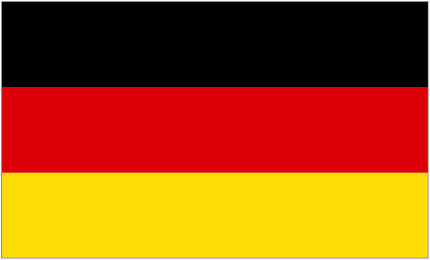 1988 - "Humanity Against Apartheid" Memorial & Anti-Colonialism Monument, Hermann-Böse-Gymnasium, Bremen (Germany). Inscription: "Fur Menchenrechte gegen APARTHEID, IGM Jegend Bremen, 1988." /// "Across from the school there is a 7 metre high brick elephant designed by the sculptor Fritz Behn, inaugurated on July 6, 1932, which became the emblem of the school. Just like the school, the monument changed from a pro-colonial monument to an anti-colonial monument in a ceremonious renaming on May 18, 1990."
1988 - "Humanity Against Apartheid" Memorial & Anti-Colonialism Monument, Hermann-Böse-Gymnasium, Bremen (Germany). Inscription: "Fur Menchenrechte gegen APARTHEID, IGM Jegend Bremen, 1988." /// "Across from the school there is a 7 metre high brick elephant designed by the sculptor Fritz Behn, inaugurated on July 6, 1932, which became the emblem of the school. Just like the school, the monument changed from a pro-colonial monument to an anti-colonial monument in a ceremonious renaming on May 18, 1990."
|


|
 1988 -Terrorism Memorial, Van der Walt and Vermeulen Streets (now renamed Lilian Ngoyi and Madiba Streets), Pretoria (South Africa). Stood at the entrance of the old Munitoria building [which was] demolished by explosion on 7th July 2013.
" The memorial's [common name] is today considered politically incorrect in the eyes of the confused & misguided sympathizers of the ANC’s Marxist-Communist FREEdom fighters.
I will stop being sarcastic the day the ANC government stops obliterating and distorting African-European heritage and makes an official announcement - that ALL CITIZENS OF SOUTH AFRICA (irrespective of colour) who lost their lives during the Cold War era also sacrificed their lives for the freedom so many people enjoy today.
The memorial was constructed in 1988 to honour '‘residents of Pretoria who lost their lives as a result of acts of terrorism, or in preventing or combating terrorism' - according to an announcement in a Council Newsletter at the time.
The symbolism of all of the individual elements of the memorial was explained in both Afrikaans & English on an attached plaque. Mounted on a rock symbolizing ‘the infallibility of God’s Word’ is a tall arch made of stainless steel, which ‘denotes the triumph of a people living by God’s principles.’ The arch is broken at the apex as a reference to ‘the untimely death of the victims of terrorism.’ The structure was originally surrounded by a water feature symbolizing ‘calmness and reflection’ & equipped with an inscription from the Bible, “Vengeance is mine: I will repay” (Romans 12:19), as well as the dedication 'To our victims of terrorism'”
1988 -Terrorism Memorial, Van der Walt and Vermeulen Streets (now renamed Lilian Ngoyi and Madiba Streets), Pretoria (South Africa). Stood at the entrance of the old Munitoria building [which was] demolished by explosion on 7th July 2013.
" The memorial's [common name] is today considered politically incorrect in the eyes of the confused & misguided sympathizers of the ANC’s Marxist-Communist FREEdom fighters.
I will stop being sarcastic the day the ANC government stops obliterating and distorting African-European heritage and makes an official announcement - that ALL CITIZENS OF SOUTH AFRICA (irrespective of colour) who lost their lives during the Cold War era also sacrificed their lives for the freedom so many people enjoy today.
The memorial was constructed in 1988 to honour '‘residents of Pretoria who lost their lives as a result of acts of terrorism, or in preventing or combating terrorism' - according to an announcement in a Council Newsletter at the time.
The symbolism of all of the individual elements of the memorial was explained in both Afrikaans & English on an attached plaque. Mounted on a rock symbolizing ‘the infallibility of God’s Word’ is a tall arch made of stainless steel, which ‘denotes the triumph of a people living by God’s principles.’ The arch is broken at the apex as a reference to ‘the untimely death of the victims of terrorism.’ The structure was originally surrounded by a water feature symbolizing ‘calmness and reflection’ & equipped with an inscription from the Bible, “Vengeance is mine: I will repay” (Romans 12:19), as well as the dedication 'To our victims of terrorism'”
|
 February 2, 1990 - Nelson Mandela is released from prison.
February 2, 1990 - Nelson Mandela is released from prison.
 July 1991 - US sanctions against South Africa are repealed.
July 1991 - US sanctions against South Africa are repealed.


 |  1993 - Luthuli House, 51-53 President Street, Inner CIty, Johannesburg (South Africa). Headquarters of the African National Congress (ANC). Previously known as Shell House, it was bought by the party from Royal Dutch Shell upon its unbanning & return to South African politics in 1993 for R20,000,000. Site of the Shell House massacre on March 28, 1994, when the building's security guards killed 19 members of the Inkatha Freedom Party who were claimed to have been participants in a plot to raid the building. It was renamed in 1998 for Chief Albert Luthuli [1898-1967]. 1993 - Luthuli House, 51-53 President Street, Inner CIty, Johannesburg (South Africa). Headquarters of the African National Congress (ANC). Previously known as Shell House, it was bought by the party from Royal Dutch Shell upon its unbanning & return to South African politics in 1993 for R20,000,000. Site of the Shell House massacre on March 28, 1994, when the building's security guards killed 19 members of the Inkatha Freedom Party who were claimed to have been participants in a plot to raid the building. It was renamed in 1998 for Chief Albert Luthuli [1898-1967].
|



 |  1993 - Robben Island Museum, Robben Island, offshore from Cape Town (South Africa). "The notorious prison on the Island was also used to exile political prisoners of the apartheid era between the 1960s and 1991. Today it is a World Heritage Site and museum, a poignant reminder to the newly democratic South Africa of the price some paid for freedom." /// "Heritage sites such as Robben Island & Constitution Hill represent the suffering of those who fought for freedom, while at the same time serving as symbols of triumph over adversity.
New heroes are being worshipped in post-apartheid monuments. [Sabine Marschall]" 1993 - Robben Island Museum, Robben Island, offshore from Cape Town (South Africa). "The notorious prison on the Island was also used to exile political prisoners of the apartheid era between the 1960s and 1991. Today it is a World Heritage Site and museum, a poignant reminder to the newly democratic South Africa of the price some paid for freedom." /// "Heritage sites such as Robben Island & Constitution Hill represent the suffering of those who fought for freedom, while at the same time serving as symbols of triumph over adversity.
New heroes are being worshipped in post-apartheid monuments. [Sabine Marschall]"
|
 April 27, 1994 - End of Apartheid. Celebratred as Freedom Day.
April 27, 1994 - End of Apartheid. Celebratred as Freedom Day.
 September 1994 - Bloemfontein (South Africa). "With the passions of centuries, the purging ritual that comes with revolution has begun in South Africa.
The statue of Hendrik Verwoerd [1901-1966], the father of apartheid, was yanked from its pedestal in the Afrikaner stronghold of Bloemfontein this month, and the black victims of a hated Government began eyeing the paintings of wigged lawmakers on Parliament walls and the busts of prime ministers that may be the next to go.
Just as the Berlin wall and statues of Lenin came down in recent years, the statue of the Prime Minister who drew the map of segregation and imposed inferior education on blacks, was wrested from his place in front of the provincial offices of the Orange Free State during a Friday afternoon rush hour..."
September 1994 - Bloemfontein (South Africa). "With the passions of centuries, the purging ritual that comes with revolution has begun in South Africa.
The statue of Hendrik Verwoerd [1901-1966], the father of apartheid, was yanked from its pedestal in the Afrikaner stronghold of Bloemfontein this month, and the black victims of a hated Government began eyeing the paintings of wigged lawmakers on Parliament walls and the busts of prime ministers that may be the next to go.
Just as the Berlin wall and statues of Lenin came down in recent years, the statue of the Prime Minister who drew the map of segregation and imposed inferior education on blacks, was wrested from his place in front of the provincial offices of the Orange Free State during a Friday afternoon rush hour..."

|
 December 1994 - District Six Museum, District Six, Cape Town (South Africa). "Works with the memories of the District Six experience & with that of forced removals more generally.
District Six was a vibrant centre with close links to the city & the port. By the beginning of the 20th century, however, the process of removals & marginalisation had begun.
The first to be forced out were black South Africans who were displaced from the District in 1901. As the more prosperous moved away to the suburbs, the area became a neglected ward of the city.
On 11 February 1966 it was declared a white area under the Group Areas Act of 1950, and by 1982, the life of the community was over. More than 60 000 people were forcibly removed to barren outlying areas aptly known as the Cape Flats, and their houses in District Six were flattened by bulldozers."
December 1994 - District Six Museum, District Six, Cape Town (South Africa). "Works with the memories of the District Six experience & with that of forced removals more generally.
District Six was a vibrant centre with close links to the city & the port. By the beginning of the 20th century, however, the process of removals & marginalisation had begun.
The first to be forced out were black South Africans who were displaced from the District in 1901. As the more prosperous moved away to the suburbs, the area became a neglected ward of the city.
On 11 February 1966 it was declared a white area under the Group Areas Act of 1950, and by 1982, the life of the community was over. More than 60 000 people were forcibly removed to barren outlying areas aptly known as the Cape Flats, and their houses in District Six were flattened by bulldozers."
|
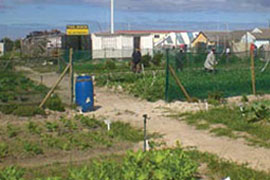 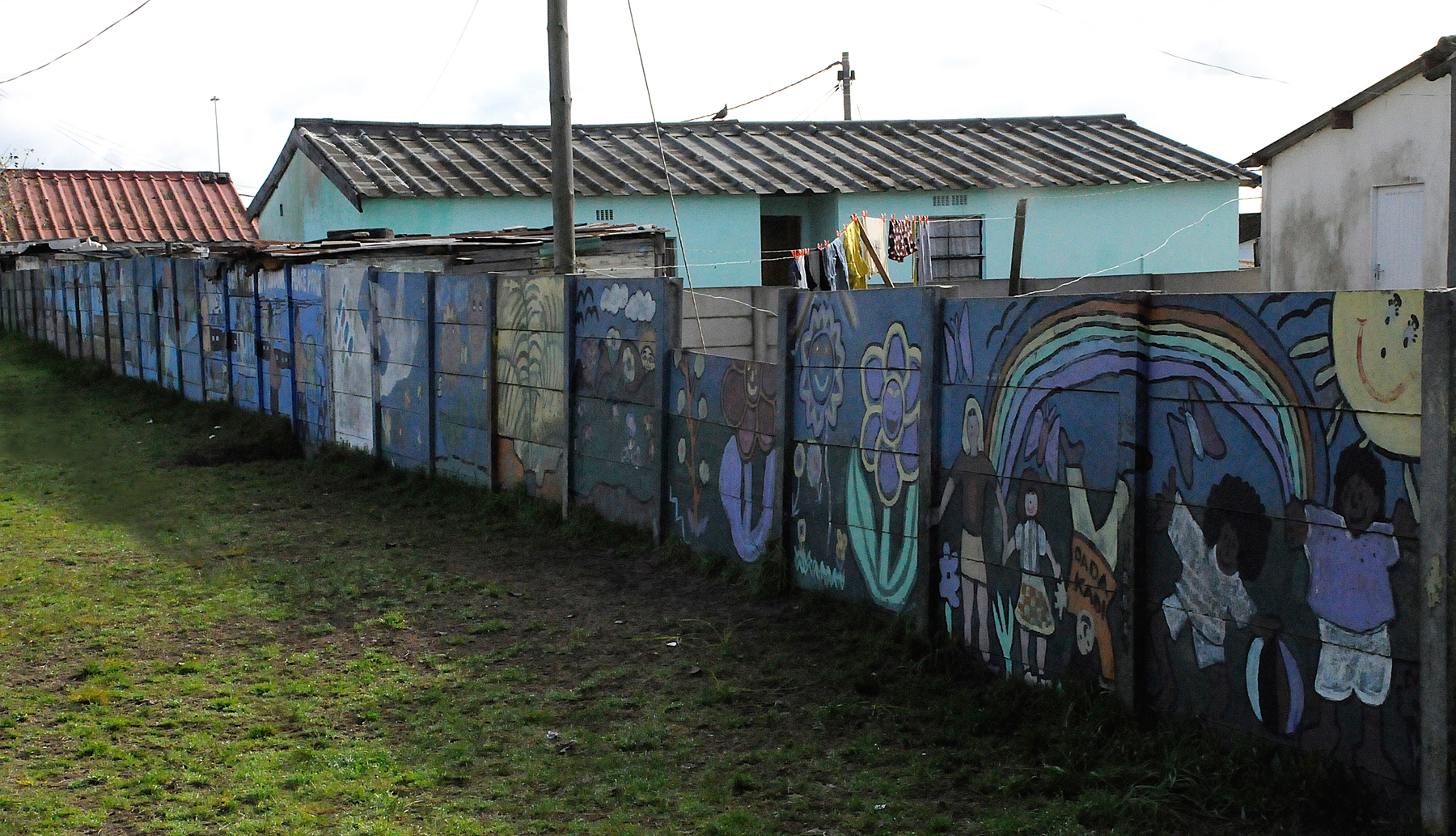
 |  1995 - Manyanani Peace Park, Khayelitsha, Cape Town (South Africa). "The name of Khayelitsha is Xhosa for 'New Home.' It is reputed to be the largest & fastest growing township in South Africa." /// "Name in Xhosa means 'to bring people together.' The development of the peace park on degraded land in the township was a bid to remove the conflict between two communities who subsequently became friends. The source of the conflict? One group was paying for services, whilst the other was not. Now both pay for their services.
Founded on the anniversary of the first democratic elections of South Africa. It is the first of its kind in Cape Town, and possibly in South Africa. The park is 1.8 hectares of land on which there are indigenous lawns, trees & groundcovers, an open air amphitheatre, pathways, benches, a half-size soccer field, an open-air basketball court, a small community centre and a playground." /// "Soon after the Peace Park was built, children in the community painted murals on the wall marking the boundary between Manyanani & the rest of Khayelitsha [right image]." 1995 - Manyanani Peace Park, Khayelitsha, Cape Town (South Africa). "The name of Khayelitsha is Xhosa for 'New Home.' It is reputed to be the largest & fastest growing township in South Africa." /// "Name in Xhosa means 'to bring people together.' The development of the peace park on degraded land in the township was a bid to remove the conflict between two communities who subsequently became friends. The source of the conflict? One group was paying for services, whilst the other was not. Now both pay for their services.
Founded on the anniversary of the first democratic elections of South Africa. It is the first of its kind in Cape Town, and possibly in South Africa. The park is 1.8 hectares of land on which there are indigenous lawns, trees & groundcovers, an open air amphitheatre, pathways, benches, a half-size soccer field, an open-air basketball court, a small community centre and a playground." /// "Soon after the Peace Park was built, children in the community painted murals on the wall marking the boundary between Manyanani & the rest of Khayelitsha [right image]."
|

 |  February 1, 1997 - Peace Parks Foundation (PPF), Stellenbosch (South Africa). "The Global Solution." "Founded by Dr Anton Rupert [1916-2006] to facilitate the establishment of transfrontier conservation areas (TFCAs). These are defined as relatively large areas which straddle frontiers between two or more countries & cover large-scale natural systems encompassing protected areas. They also incorporate biosphere reserves & a wide range of community-based natural resource management programmes.
The term 'peace park' was coined by the World Conservation Union (IUCN) to describe a transfrontier conservation area which:
* encompasses more then one nation,
* unifies fragmented ecological habitats [and]
* promotes environmental and political stability.
The overall objective of PPF is to facilitate the development of regional and international partnerships to promote job creation and biodiversity conservation involving Botswana, Lesotho, Namibia, Mozambique, South Africa, Swaziland, Zimbabwe, Angola, Zambia, Malawi and Tanzania." /// "
Willem van Riet, formerly of Van Riet & Louw Landscape Architects, is the current CEO of the PPPF. Contrary to the landscape industry’s belief that he may have retired, he is in fact actively working on the continued existence of the Foundation and the furtherance of its goals.
Van Riet took over from Dr John Hanks who retired in 2000. He (van Riet) had already carried out the first plans for the Great Limpopo Park in 1996 and explains: 'Van Riet and Louw were always involved in the landscape planning of parks and my joining PPF was a natural progression of this. I took with me my GIS experience developed at the University of Pretoria some six years earlier and together with the staff who joined me, we approached the Foundation from a technical planning point of view. We conceptualised and produced a landscape use plan to improve the life of rural communities, one of the prerequisites for the development of TFCAs.'" February 1, 1997 - Peace Parks Foundation (PPF), Stellenbosch (South Africa). "The Global Solution." "Founded by Dr Anton Rupert [1916-2006] to facilitate the establishment of transfrontier conservation areas (TFCAs). These are defined as relatively large areas which straddle frontiers between two or more countries & cover large-scale natural systems encompassing protected areas. They also incorporate biosphere reserves & a wide range of community-based natural resource management programmes.
The term 'peace park' was coined by the World Conservation Union (IUCN) to describe a transfrontier conservation area which:
* encompasses more then one nation,
* unifies fragmented ecological habitats [and]
* promotes environmental and political stability.
The overall objective of PPF is to facilitate the development of regional and international partnerships to promote job creation and biodiversity conservation involving Botswana, Lesotho, Namibia, Mozambique, South Africa, Swaziland, Zimbabwe, Angola, Zambia, Malawi and Tanzania." /// "
Willem van Riet, formerly of Van Riet & Louw Landscape Architects, is the current CEO of the PPPF. Contrary to the landscape industry’s belief that he may have retired, he is in fact actively working on the continued existence of the Foundation and the furtherance of its goals.
Van Riet took over from Dr John Hanks who retired in 2000. He (van Riet) had already carried out the first plans for the Great Limpopo Park in 1996 and explains: 'Van Riet and Louw were always involved in the landscape planning of parks and my joining PPF was a natural progression of this. I took with me my GIS experience developed at the University of Pretoria some six years earlier and together with the staff who joined me, we approached the Foundation from a technical planning point of view. We conceptualised and produced a landscape use plan to improve the life of rural communities, one of the prerequisites for the development of TFCAs.'"
|

|
 1997 - Bisho Massacre Memorial, outside Independence Stadium, off Maitland Road between Bhisho & King William's Town (South Africa). A granite monument on the site of the massacre. Unveiled by Archbishop Desmond Tutu. The victims were buried in Ginsberg township outside King William's Town. "The Bisho massacre occurred on 7 September 1992 in Bisho, in the nominally independent homeland of Ciskei. Twenty-eight African National Congress supporters & one soldier were shot dead by the Ciskei Defence Force during a protest march when they attempted to enter Bisho (now renamed to Bhisho) to demand the reincorporation of Ciskei into South Africa during the final years of apartheid."
1997 - Bisho Massacre Memorial, outside Independence Stadium, off Maitland Road between Bhisho & King William's Town (South Africa). A granite monument on the site of the massacre. Unveiled by Archbishop Desmond Tutu. The victims were buried in Ginsberg township outside King William's Town. "The Bisho massacre occurred on 7 September 1992 in Bisho, in the nominally independent homeland of Ciskei. Twenty-eight African National Congress supporters & one soldier were shot dead by the Ciskei Defence Force during a protest march when they attempted to enter Bisho (now renamed to Bhisho) to demand the reincorporation of Ciskei into South Africa during the final years of apartheid."
|

|  September 12, 1997 - Statue of Steve Biko, City Hall, Oxford Street, East London (South Africa). By Naomi Jacobson. Biko was the Black Consciousness Movement leader who died in police custody. /// "[On the same day] Nelson Mandela dedicated the statue, attended the [re]naming ceremony of the Biko Bridge [from Vorster Bridge] & dedicated another monument at Biko’s home in Ginsberg (near King William’s Town)." ///"Bronze statues on pedestals are proliferating throughout the country (e.g., of Nelson Mandela; Steve Biko; Gandhi; Albert Luthuli; Solomon Mahlangu; John Dube, etc.). [Sabine Marschall]" September 12, 1997 - Statue of Steve Biko, City Hall, Oxford Street, East London (South Africa). By Naomi Jacobson. Biko was the Black Consciousness Movement leader who died in police custody. /// "[On the same day] Nelson Mandela dedicated the statue, attended the [re]naming ceremony of the Biko Bridge [from Vorster Bridge] & dedicated another monument at Biko’s home in Ginsberg (near King William’s Town)." ///"Bronze statues on pedestals are proliferating throughout the country (e.g., of Nelson Mandela; Steve Biko; Gandhi; Albert Luthuli; Solomon Mahlangu; John Dube, etc.). [Sabine Marschall]"
|

|  1999 - Cape Town Holocaust Centre, 88 Hatfield Street Gardens, Cape Town (South Africa). "First Holocaust Centre in Africa, opened in 1999. Houses a permanent exhibition, and conducts educational programmes
for schools, educators and diverse adult groups. The permanent exhibition on the history of the Holocaust, combines text, archival photographs and film footage, documents, multimedia displays and recreated environments.
The display also includes sections on the pseudo-science of ‘race;’ the roots of antisemitism, and the institutionalised racism of Apartheid.
A photographic display and 20 minute documentary tells the story of the survivors of the Holocaust who made their home in Cape Town." /// Additional Holocaust Centres opened in Johannesburg (January 2008) & Durban (March 2009). 1999 - Cape Town Holocaust Centre, 88 Hatfield Street Gardens, Cape Town (South Africa). "First Holocaust Centre in Africa, opened in 1999. Houses a permanent exhibition, and conducts educational programmes
for schools, educators and diverse adult groups. The permanent exhibition on the history of the Holocaust, combines text, archival photographs and film footage, documents, multimedia displays and recreated environments.
The display also includes sections on the pseudo-science of ‘race;’ the roots of antisemitism, and the institutionalised racism of Apartheid.
A photographic display and 20 minute documentary tells the story of the survivors of the Holocaust who made their home in Cape Town." /// Additional Holocaust Centres opened in Johannesburg (January 2008) & Durban (March 2009). 
|

|  1999 "Non-Violence," Victoria & Albert Waterfront, Cape Town (South Africa). One of about 20 reproductions of original sculpture by Carl Fredrik Reuterswärd:
As many as 20 "knotted gun" monuments in different countries. Reuterswärd has written that the grieving after John Lennon was murdered inspired him to design this artwork. 1999 "Non-Violence," Victoria & Albert Waterfront, Cape Town (South Africa). One of about 20 reproductions of original sculpture by Carl Fredrik Reuterswärd:
As many as 20 "knotted gun" monuments in different countries. Reuterswärd has written that the grieving after John Lennon was murdered inspired him to design this artwork.
|

|  2010 - Knot Violence – Futbol for Peace campaign, Cape Town (South Africa). "The organization Get The Point that put up the original knotted gun at the V&A Waterfront (and all over the world), approached Y&R Cape Town for this project. Bafana Bafana captain Aaron Mokoena and a few others got involved and these guns are up at the Waterfront for the duration of the world cup. Their aim is to involve young people in proactive alternatives to violence." 2010 - Knot Violence – Futbol for Peace campaign, Cape Town (South Africa). "The organization Get The Point that put up the original knotted gun at the V&A Waterfront (and all over the world), approached Y&R Cape Town for this project. Bafana Bafana captain Aaron Mokoena and a few others got involved and these guns are up at the Waterfront for the duration of the world cup. Their aim is to involve young people in proactive alternatives to violence."
|
2000:
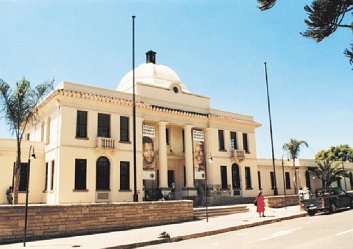
|
 February 2, 2000 - Nelson Mandela Museum, Qunu & Mthatha, Eastern Cape Province (South Africa). "Established on the 10th anniversary of Mr Mandela’s release from prison – in the great man’s lifetime, and...had the pleasure of hosting him at its facilities in Qunu and Mthatha over the years. Being able to personally interact with their subject is a rare privilege for heritage institutions that are more commonly established only after the passing of the people who inspired them... The Museum’s Footprints Trail extends from its physical facilities, through the schools & churches once attended by Mr Mandela, through the playground of his childhood, through the villages that nurtured him, to the towns & cities beyond."
February 2, 2000 - Nelson Mandela Museum, Qunu & Mthatha, Eastern Cape Province (South Africa). "Established on the 10th anniversary of Mr Mandela’s release from prison – in the great man’s lifetime, and...had the pleasure of hosting him at its facilities in Qunu and Mthatha over the years. Being able to personally interact with their subject is a rare privilege for heritage institutions that are more commonly established only after the passing of the people who inspired them... The Museum’s Footprints Trail extends from its physical facilities, through the schools & churches once attended by Mr Mandela, through the playground of his childhood, through the villages that nurtured him, to the towns & cities beyond."
|



|  February 27, 2000 - Sarvodaya, Phoenix Settlement, Bambayi, Inanda, about 25 km from central Durban (South Africa). "Gandhi's original house." Razed to the ground by apartheid violence in 1985. Restored & dedicated February 27, 2000, by South African president Thabo Mbeki. February 27, 2000 - Sarvodaya, Phoenix Settlement, Bambayi, Inanda, about 25 km from central Durban (South Africa). "Gandhi's original house." Razed to the ground by apartheid violence in 1985. Restored & dedicated February 27, 2000, by South African president Thabo Mbeki.
|

|  Date? - Bust of Mahatma Gandhi, Phoenix Settlement, Inanda, about 25 km from central Durban (South Africa). Photo shows Indian Prime Minister Dr. Manmohan Singh and the President of South Africa, Mr. Thabo Mbeki, jointly garlanding the bust of Mahatma Gandhi on October 1, 2006. Date? - Bust of Mahatma Gandhi, Phoenix Settlement, Inanda, about 25 km from central Durban (South Africa). Photo shows Indian Prime Minister Dr. Manmohan Singh and the President of South Africa, Mr. Thabo Mbeki, jointly garlanding the bust of Mahatma Gandhi on October 1, 2006. 
|



|   May 12, 2000 - Kgalagadi Transfrontier Park, Twee Rivieren/Two Rivers (South Africa & Botswana). "An amalgamation of the Kalahari Gemsbok National Park in South Africa (proclaimed in 1931) & the Gemsbok National Park in Botswana. Comprises an area of over 3,6 million hectares – one of very few conservation areas of this magnitude left in the world." May 12, 2000 - Kgalagadi Transfrontier Park, Twee Rivieren/Two Rivers (South Africa & Botswana). "An amalgamation of the Kalahari Gemsbok National Park in South Africa (proclaimed in 1931) & the Gemsbok National Park in Botswana. Comprises an area of over 3,6 million hectares – one of very few conservation areas of this magnitude left in the world."
|

|  2000 - Peace Monument, at the Waterfront in front of the Information Office, Limpopo & Bela-Bela CTA, Bela-Bela (Warmbaths) , Limpopo Province (South Africa). "The monument is one of only a few in the Limpopo." 2000 - Peace Monument, at the Waterfront in front of the Information Office, Limpopo & Bela-Bela CTA, Bela-Bela (Warmbaths) , Limpopo Province (South Africa). "The monument is one of only a few in the Limpopo."
|

|
 August 22, 2000 - Cradock
Four Memorial, Cradock (South Africa). "The Cradock Four were abducted while travelling from Port Elizabeth to Cradock in 1985. They were then taken to Olifantshoek Pass and later to Port Elizabeth, where they were assaulted, killed & their bodies & vehicle were burnt on 27 June 1985.
Three Security Branch policemen, a Sergeant Faku, Sergeant Mgoduka & one Sakati who participated in the killing of the activists were later killed in a car bomb blast at Motherwell in 1989."
August 22, 2000 - Cradock
Four Memorial, Cradock (South Africa). "The Cradock Four were abducted while travelling from Port Elizabeth to Cradock in 1985. They were then taken to Olifantshoek Pass and later to Port Elizabeth, where they were assaulted, killed & their bodies & vehicle were burnt on 27 June 1985.
Three Security Branch policemen, a Sergeant Faku, Sergeant Mgoduka & one Sakati who participated in the killing of the activists were later killed in a car bomb blast at Motherwell in 1989."
|

|
 Date? - Cradock
Four Memorial, Cradock (South Africa). "Over the weekend we paid a very depressing visit to the Cradock Four Memorial just outside Cradock. The site is in an appalling condition and is an insult to the memory of Matthew Goniwe, Fort Calata, Sparrow Mkhonto & Sicelo Mhlauli.
The four concrete pillars of the memorial are visible from the N10 as you approach Cradock from Bedford, but getting there is another story altogether. The signage is poor to non-existent making it very easy to miss the dirt road to the site.
Once there the desolation of the place is clearly evident. One lone security guard watches over unfinished & abandoned structures connected by overgrown pathways. He tells us of the once grand vision & then sighs at the gloomy reality. What should be a thriving tourist attraction & educational facility is an embarrassment to the Province & Country." /// "Group memorials are dedicated to those who sacrificed their lives—usually young, always male, political activists whose death is associated with a tragic event and brutal murder by the security forces. The dramatic story of the deathly incident and the complex narrative of their lives are condensed into one succinct, catchphrase label: the Gugulethu Seven, the Cradock Four, the Pebco Three. [Sabine Marschall]"
Date? - Cradock
Four Memorial, Cradock (South Africa). "Over the weekend we paid a very depressing visit to the Cradock Four Memorial just outside Cradock. The site is in an appalling condition and is an insult to the memory of Matthew Goniwe, Fort Calata, Sparrow Mkhonto & Sicelo Mhlauli.
The four concrete pillars of the memorial are visible from the N10 as you approach Cradock from Bedford, but getting there is another story altogether. The signage is poor to non-existent making it very easy to miss the dirt road to the site.
Once there the desolation of the place is clearly evident. One lone security guard watches over unfinished & abandoned structures connected by overgrown pathways. He tells us of the once grand vision & then sighs at the gloomy reality. What should be a thriving tourist attraction & educational facility is an embarrassment to the Province & Country." /// "Group memorials are dedicated to those who sacrificed their lives—usually young, always male, political activists whose death is associated with a tragic event and brutal murder by the security forces. The dramatic story of the deathly incident and the complex narrative of their lives are condensed into one succinct, catchphrase label: the Gugulethu Seven, the Cradock Four, the Pebco Three. [Sabine Marschall]"
|

|  December 7, 2000 -
South African Peace Pagoda, The Manger, Barrydale, Western Cape Province (South Africa). Only peace pagoda in Africa. Consecrated by Sayadaw U Thila Wunta [1912-2011], eminent 90-year-old Burmese monk. "A gift he had long wanted to bestow on Africa, thus completing his dream and mission to promote peace and harmony in every continent of the world.... The building of this seven-meter tall gold structure, crowned with a spherical crystal and copper umbrella, was achieved in three weeks by Sayadaw, three Burmese Monks, 20 Canadians, and several local people." December 7, 2000 -
South African Peace Pagoda, The Manger, Barrydale, Western Cape Province (South Africa). Only peace pagoda in Africa. Consecrated by Sayadaw U Thila Wunta [1912-2011], eminent 90-year-old Burmese monk. "A gift he had long wanted to bestow on Africa, thus completing his dream and mission to promote peace and harmony in every continent of the world.... The building of this seven-meter tall gold structure, crowned with a spherical crystal and copper umbrella, was achieved in three weeks by Sayadaw, three Burmese Monks, 20 Canadians, and several local people."
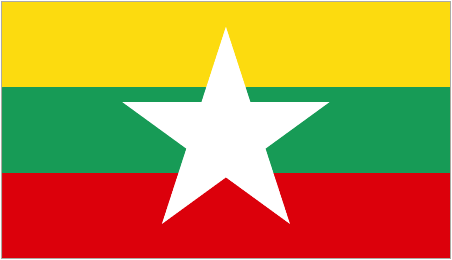 
|

|  December 2000 - South African Jewish Museum, 88 Hatfield Street, Johannesburg (South Africa). "Officially opened by Nelson Mandela... Set in the heart of the Company's Garden in Museum Mile, it is a major attraction for local and international tourism.
The entrance to the museum is situated in the Old Synagogue, the first synagogue built in South Africa in 1863. This is linked to the new gallery by a bridge - the bridge between the old and the new - the gangplank to the shores of the Cape and the immigrants' new homeland." /// Image shows Jerusalem stone facade. December 2000 - South African Jewish Museum, 88 Hatfield Street, Johannesburg (South Africa). "Officially opened by Nelson Mandela... Set in the heart of the Company's Garden in Museum Mile, it is a major attraction for local and international tourism.
The entrance to the museum is situated in the Old Synagogue, the first synagogue built in South Africa in 1863. This is linked to the new gallery by a bridge - the bridge between the old and the new - the gangplank to the shores of the Cape and the immigrants' new homeland." /// Image shows Jerusalem stone facade.
|
2001:

|  2001 - Apartheid Museum, Southdale, Johannesburg (South Africa). " The pre-eminent museum in the world dealing with 20th century South Africa, at the heart of which is the apartheid story... The Gold Reef City Casino was built and an adjacent piece of land given for the construction of a museum... Illustrates the rise and fall of apartheid...
The exhibits have been assembled and organised by a multi-disciplinary team of curators, film-makers, historians and designers. They include provocative film footage, photographs, text panels and artefacts illustrating the events and human stories that are part of the epic saga, known as apartheid.
A series of 22 individual exhibition areas takes the visitor through a dramatic emotional journey that tells a story of a state-sanctioned system based on racial discrimination and the struggle of the majority to overthrow this tyranny."
/// "The seven pillars of South Africa’s current constitution [are] displayed outside the Apartheid Museum: Democracy, equality, reconciliation, diversity, responsibility, respect & freedom." 2001 - Apartheid Museum, Southdale, Johannesburg (South Africa). " The pre-eminent museum in the world dealing with 20th century South Africa, at the heart of which is the apartheid story... The Gold Reef City Casino was built and an adjacent piece of land given for the construction of a museum... Illustrates the rise and fall of apartheid...
The exhibits have been assembled and organised by a multi-disciplinary team of curators, film-makers, historians and designers. They include provocative film footage, photographs, text panels and artefacts illustrating the events and human stories that are part of the epic saga, known as apartheid.
A series of 22 individual exhibition areas takes the visitor through a dramatic emotional journey that tells a story of a state-sanctioned system based on racial discrimination and the struggle of the majority to overthrow this tyranny."
/// "The seven pillars of South Africa’s current constitution [are] displayed outside the Apartheid Museum: Democracy, equality, reconciliation, diversity, responsibility, respect & freedom."
|

|
 2001 - Sharpeville Human Rights Precinct, Sedibeng township, Sharpeville (South Africa).
"A memorial to victims of the watershed event [on 21 March 1960] that was the beginning of the end of apartheid...
That Monday over 300 people marched on the police station in Sharpeville to hand in their pass books. A total of 69 people (including 13 anonymous foreigners) were shot dead and 180 injured when police opened fire. Many were shot in the back...
In 1966 the UN declared 21 March the International Day for the Elimination of Racial Discrimination & since the first democratic elections in South Africa in 1994 it is remembered as Human Rights Day.
Opened by Nelson Mandela, the Memorial features a dramatic wall at the entrance containing the names of the dead, who are buried in the nearby Sharpeville Cemetery, and 69 pillars in a garden split by a stream flowing from a fountain. Mandela named Sharpeville the Cradle of Human Rights."
2001 - Sharpeville Human Rights Precinct, Sedibeng township, Sharpeville (South Africa).
"A memorial to victims of the watershed event [on 21 March 1960] that was the beginning of the end of apartheid...
That Monday over 300 people marched on the police station in Sharpeville to hand in their pass books. A total of 69 people (including 13 anonymous foreigners) were shot dead and 180 injured when police opened fire. Many were shot in the back...
In 1966 the UN declared 21 March the International Day for the Elimination of Racial Discrimination & since the first democratic elections in South Africa in 1994 it is remembered as Human Rights Day.
Opened by Nelson Mandela, the Memorial features a dramatic wall at the entrance containing the names of the dead, who are buried in the nearby Sharpeville Cemetery, and 69 pillars in a garden split by a stream flowing from a fountain. Mandela named Sharpeville the Cradle of Human Rights."
|
2002:
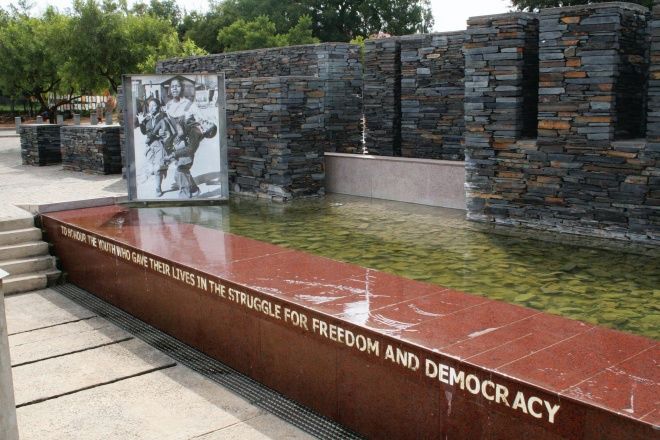
|
 June 16, 2002 - Hector Pieterson Memorial & Museum, Orlando West, Soweto, Johannesburg (South Africa). "Near the place Hector Pieterson [1963-1976] was shot during the 1976 Soweto uprising. Has become a major tourist attraction. The start of the museum begins with pictures of Hector Pierterson's death. The museum fuses memorabilia with modern technology and cultural history. Currently, in 2010, Hector's sister Antoinette, who is seen in the famous photograph, works at the museum as a tour guide." /// "A range of 'massacre memorials' has been built throughout the country... In emotionally charged images, symbols & texts, all these structures tend to recount slightly different, locally specific, versions of the same story: A group of innocent people, protesting peacefully, is brutally slaughtered by ruthless security forces. The Hector Pieterson Memorial is the epitome of this type, with its emphasis on children as symbols of innocence & vulnerability. [Sabine Marschall]"
June 16, 2002 - Hector Pieterson Memorial & Museum, Orlando West, Soweto, Johannesburg (South Africa). "Near the place Hector Pieterson [1963-1976] was shot during the 1976 Soweto uprising. Has become a major tourist attraction. The start of the museum begins with pictures of Hector Pierterson's death. The museum fuses memorabilia with modern technology and cultural history. Currently, in 2010, Hector's sister Antoinette, who is seen in the famous photograph, works at the museum as a tour guide." /// "A range of 'massacre memorials' has been built throughout the country... In emotionally charged images, symbols & texts, all these structures tend to recount slightly different, locally specific, versions of the same story: A group of innocent people, protesting peacefully, is brutally slaughtered by ruthless security forces. The Hector Pieterson Memorial is the epitome of this type, with its emphasis on children as symbols of innocence & vulnerability. [Sabine Marschall]"
|

|  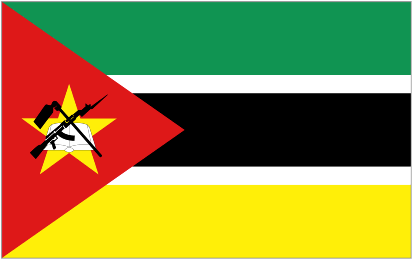 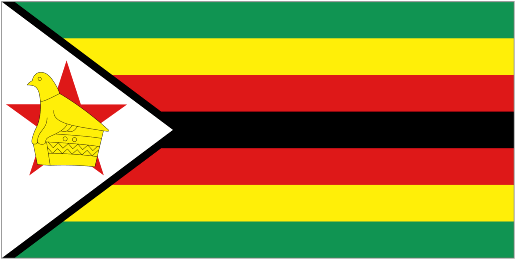 December 9, 2002 - Great Limpopo Transfrontier Park (South Africa, Mozambique &
Zimbabwe). Unites Kruger National Park in SA, Limpopo NP in Mozambique & Gonarezhou NP in Zimbabwe. "The three heads of state signed a treaty [memorandum of understanding?] establishing Great Limpopo on 9 December 2002. In 2006, the Giriyondo Access Facility between the Kruger & Limpopo national parks was opened. Almost 5 000 animals have been translocated from Kruger to Limpopo National Park. This, combined with 50 km of fence being dropped, has encouraged more animals, including more than 1 000 elephants, to cross the border of their own accord. The harmonisation & integration of various policies to improve the cooperative management of the transfrontier park are under way. Processes such as standardising a fee and rate structure, introducing a border-crossing protocol & a tourism strategy that will optimise the transfrontier park’s tourism development opportunities, in particular cross-border products, are also far advanced." /// This is one
of several projects of the Peace Parks Foundation (PPF) of Stellenbosch (South Africa). December 9, 2002 - Great Limpopo Transfrontier Park (South Africa, Mozambique &
Zimbabwe). Unites Kruger National Park in SA, Limpopo NP in Mozambique & Gonarezhou NP in Zimbabwe. "The three heads of state signed a treaty [memorandum of understanding?] establishing Great Limpopo on 9 December 2002. In 2006, the Giriyondo Access Facility between the Kruger & Limpopo national parks was opened. Almost 5 000 animals have been translocated from Kruger to Limpopo National Park. This, combined with 50 km of fence being dropped, has encouraged more animals, including more than 1 000 elephants, to cross the border of their own accord. The harmonisation & integration of various policies to improve the cooperative management of the transfrontier park are under way. Processes such as standardising a fee and rate structure, introducing a border-crossing protocol & a tourism strategy that will optimise the transfrontier park’s tourism development opportunities, in particular cross-border products, are also far advanced." /// This is one
of several projects of the Peace Parks Foundation (PPF) of Stellenbosch (South Africa).
|
2003:
 

 |  June 2003 - World Wall for Peace (WWFP), Ennerdale High School, near Johannesburg (South Africa). One of many walls in different countries named by World Walls for Peace (Carolyna Marks), Berkeley, California (USA). June 2003 - World Wall for Peace (WWFP), Ennerdale High School, near Johannesburg (South Africa). One of many walls in different countries named by World Walls for Peace (Carolyna Marks), Berkeley, California (USA). 
|
 |  2003 - Nelson Mandela Bridge, Johannesburg (South Africa). Links north & south Johannesburg. "Largest cable-stayed bridge in the South." 2003 - Nelson Mandela Bridge, Johannesburg (South Africa). Links north & south Johannesburg. "Largest cable-stayed bridge in the South."
|
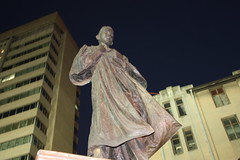
|  October 2, 2003 - Statue of Matahma Gandhi, Gandhi Square, Central Business District, Johannesburg (South Africa). 2.5 metre statue by Tinka Christopher depicts Gandhi as a young lawyer in Johannesburg. /// "Bronze statues on pedestals are proliferating throughout the country (e.g., of Nelson Mandela; Steve Biko; Gandhi; Albert Luthuli; Solomon Mahlangu; John Dube, etc.). [Sabine Marschall]" October 2, 2003 - Statue of Matahma Gandhi, Gandhi Square, Central Business District, Johannesburg (South Africa). 2.5 metre statue by Tinka Christopher depicts Gandhi as a young lawyer in Johannesburg. /// "Bronze statues on pedestals are proliferating throughout the country (e.g., of Nelson Mandela; Steve Biko; Gandhi; Albert Luthuli; Solomon Mahlangu; John Dube, etc.). [Sabine Marschall]"
|
 
 |  December 14, 2003 - Monument of South Africa's Nobel Peace prize winners, Nobel Square, Victoria & Alfred Waterfront, Cape Town (South Africa). Depicts Albert Luthuli (1960), Bishop Desmond TuTu (1984), Nelson Mandela (1993) & William De Klerk (1993). Only De Klerk & Mandela shown in right image. "It is a source of tremendous pride that the country achieved freedom for all its people without civil war." /// Sculpted by Claudette Schreuders. /// Click here for dedication speech by Nelson Mandela. December 14, 2003 - Monument of South Africa's Nobel Peace prize winners, Nobel Square, Victoria & Alfred Waterfront, Cape Town (South Africa). Depicts Albert Luthuli (1960), Bishop Desmond TuTu (1984), Nelson Mandela (1993) & William De Klerk (1993). Only De Klerk & Mandela shown in right image. "It is a source of tremendous pride that the country achieved freedom for all its people without civil war." /// Sculpted by Claudette Schreuders. /// Click here for dedication speech by Nelson Mandela. 
|
2004:


|
 March 31, 2004 - Statue of Nelson Mandela, Sandton City Shopping Centre, Nelson Mandela Square, Johannesburg (South Africa). "Formerly known as Sandton Square, it was renamed Nelson Mandela Square on 31 March 2004 after a 6-metre statue of Nelson Mandela was installed on the square to honour the former South African president. It is attached to the large Sandton City shopping centre." /// "Bronze statues on pedestals are proliferating throughout the country (e.g., of Nelson Mandela; Steve Biko; Gandhi; Albert Luthuli; Solomon Mahlangu; John Dube, etc.). [Sabine Marschall]"
March 31, 2004 - Statue of Nelson Mandela, Sandton City Shopping Centre, Nelson Mandela Square, Johannesburg (South Africa). "Formerly known as Sandton Square, it was renamed Nelson Mandela Square on 31 March 2004 after a 6-metre statue of Nelson Mandela was installed on the square to honour the former South African president. It is attached to the large Sandton City shopping centre." /// "Bronze statues on pedestals are proliferating throughout the country (e.g., of Nelson Mandela; Steve Biko; Gandhi; Albert Luthuli; Solomon Mahlangu; John Dube, etc.). [Sabine Marschall]" 
|
 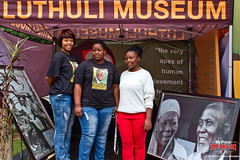

|
 August 21, 2004 - Albert Luthuli House & Museum, Groutville, KwaDukuza (ex-Stanger), Natal (South Africa). Albert Luthuli [c1898-1967] "was elected president of the African National Congress (ANC), at the time an umbrella organisation that led opposition to the white minority government in South Africa. He was awarded the 1960 Nobel Peace Prize for his role in the non-violent struggle against apartheid. He was the first African, and the first person from outside Europe and the Americas, to be awarded the Nobel Peace Prize." /// "The modest homes of several struggle icons have been preserved and turned into a museum. This includes the Mandela residence in Soweto, Albert Luthuli’s house in Groutville, or John Dube’s house in Inanda. [Sabine Marschall]"
August 21, 2004 - Albert Luthuli House & Museum, Groutville, KwaDukuza (ex-Stanger), Natal (South Africa). Albert Luthuli [c1898-1967] "was elected president of the African National Congress (ANC), at the time an umbrella organisation that led opposition to the white minority government in South Africa. He was awarded the 1960 Nobel Peace Prize for his role in the non-violent struggle against apartheid. He was the first African, and the first person from outside Europe and the Americas, to be awarded the Nobel Peace Prize." /// "The modest homes of several struggle icons have been preserved and turned into a museum. This includes the Mandela residence in Soweto, Albert Luthuli’s house in Groutville, or John Dube’s house in Inanda. [Sabine Marschall]" 
|
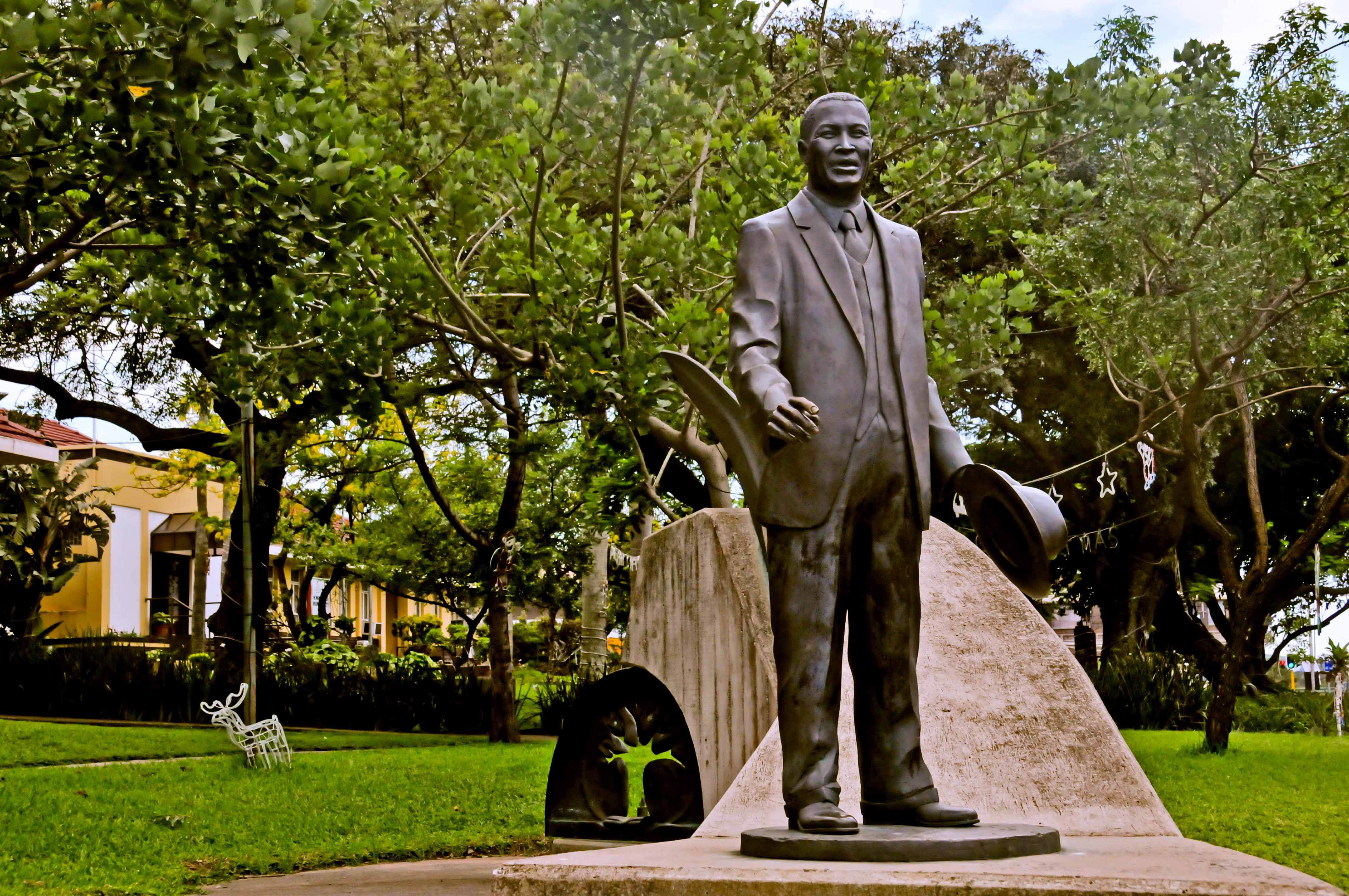 |  August 21, 2004 - Statue of Albert Luthuli, KwaDukuza municipal grounds, King Shaka & Chief Albert Luthuli Streets, KwaDukuza (ex-Stanger), KwaZulu-Natal (South Africa). By sculptor Gene Swart. /// "Bronze statues on pedestals are proliferating throughout the country (e.g., of Nelson Mandela; Steve Biko; Gandhi; Albert Luthuli; Solomon Mahlangu; John Dube, etc.). [Sabine Marschall]" August 21, 2004 - Statue of Albert Luthuli, KwaDukuza municipal grounds, King Shaka & Chief Albert Luthuli Streets, KwaDukuza (ex-Stanger), KwaZulu-Natal (South Africa). By sculptor Gene Swart. /// "Bronze statues on pedestals are proliferating throughout the country (e.g., of Nelson Mandela; Steve Biko; Gandhi; Albert Luthuli; Solomon Mahlangu; John Dube, etc.). [Sabine Marschall]" 
|
2005:
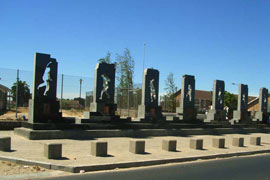
|
 March 21, 2005 - Gugulethu Seven Monument, Gugulethu, Cape Town (South Africa). Outside the Gugulethu police station on the corner of NY1 & NY111. Dedicated on Human Rights Day. "Remembers the brutal murder of seven young black activists by South African security forces on 3 March 1986. The young men were on their way to what they believed to be a job interview in a minivan driven by an undercover security officer, when they stopped at a roadblock and the police opened fire. Security forces covered up the crime, claiming it was an act of terrorism, but the real story was exposed during the Truth & Reconciliation process, and a memorial now stands at the sight where they were killed."
March 21, 2005 - Gugulethu Seven Monument, Gugulethu, Cape Town (South Africa). Outside the Gugulethu police station on the corner of NY1 & NY111. Dedicated on Human Rights Day. "Remembers the brutal murder of seven young black activists by South African security forces on 3 March 1986. The young men were on their way to what they believed to be a job interview in a minivan driven by an undercover security officer, when they stopped at a roadblock and the police opened fire. Security forces covered up the crime, claiming it was an act of terrorism, but the real story was exposed during the Truth & Reconciliation process, and a memorial now stands at the sight where they were killed."
|
 

|
 June 26, 2005 - Freedom Charter Monument, Walter Sisulu Square of Dedication, Kliptown Soweto, Johannesburg (South Africa).
"Kliptown was established in 1903 and is Joburg's oldest urban all-race settlement. Construction of the square, the heart of the township, began in 2003 & used stone called 'klip."
It has 10 columns, topped with 10 sculptures, symbolising the tenets in the Freedom Charter.
A meeting was called [on June 26, 1955] by a group of anti-apartheid activists, the Congress of the People, at the open area in Kliptown to discuss and endorse the Freedom Charter...
Previously called Freedom Square in line with its history, the Walter Sisulu Square of Dedication was opened on the 50th anniversary of the meeting. It consists of two squares, each 100 metres by 100 metres in size, made of nine smaller squares, with large crosses inside them, representing the votes cast in the first democratic elections in 1994.
The Freedom Charter is the basis of today's Constitution." /// Right image shows Prince Charles and his wife Camilla November 3, 2011, viewing the text of the Freedom Charter on a round stone inside the monument. /// "The quest for freedom is reflected in such heritage sites as Freedom Valley in Inanda, Freedom Square in Kliptown, the planned Freedom Statue in Port Elizabeth, Freedom Square in Pietermaritzburg... [Sabine Marschall]"
June 26, 2005 - Freedom Charter Monument, Walter Sisulu Square of Dedication, Kliptown Soweto, Johannesburg (South Africa).
"Kliptown was established in 1903 and is Joburg's oldest urban all-race settlement. Construction of the square, the heart of the township, began in 2003 & used stone called 'klip."
It has 10 columns, topped with 10 sculptures, symbolising the tenets in the Freedom Charter.
A meeting was called [on June 26, 1955] by a group of anti-apartheid activists, the Congress of the People, at the open area in Kliptown to discuss and endorse the Freedom Charter...
Previously called Freedom Square in line with its history, the Walter Sisulu Square of Dedication was opened on the 50th anniversary of the meeting. It consists of two squares, each 100 metres by 100 metres in size, made of nine smaller squares, with large crosses inside them, representing the votes cast in the first democratic elections in 1994.
The Freedom Charter is the basis of today's Constitution." /// Right image shows Prince Charles and his wife Camilla November 3, 2011, viewing the text of the Freedom Charter on a round stone inside the monument. /// "The quest for freedom is reflected in such heritage sites as Freedom Valley in Inanda, Freedom Square in Kliptown, the planned Freedom Statue in Port Elizabeth, Freedom Square in Pietermaritzburg... [Sabine Marschall]"
|

|
 September 17, 2005 - Statue of Solomon Mahlangu, Solomon Mahlangu Freedom Square, Mamelodi, Tshwane, Pretoria, Gauteng (South Africa). Solomon Mahlangu [1956-1979] was a uMkhonto we Sizwe/Spear of the Nation soldier. "His execution on 6 April 1979 resulted in an unprecedented international condemnation of the then South African Government." The square was dedicated in 1993. /// "Once off casting, using the "lost-wax" process sculpted by Angus Taylor. Approximately twice life-size in combat uniform, with laced boots, a beret under his left epaulette and 'standing at ease' with his legs slightly apart. The forearm of the right arm extends outwards with his palm facing upwards & supporting a sphere or 'world of opportunity.'"
/// "Bronze statues on pedestals are proliferating throughout the country (e.g., of Nelson Mandela; Steve Biko; Gandhi; Albert Luthuli; Solomon Mahlangu; John Dube, etc.). [Sabine Marschall]"
September 17, 2005 - Statue of Solomon Mahlangu, Solomon Mahlangu Freedom Square, Mamelodi, Tshwane, Pretoria, Gauteng (South Africa). Solomon Mahlangu [1956-1979] was a uMkhonto we Sizwe/Spear of the Nation soldier. "His execution on 6 April 1979 resulted in an unprecedented international condemnation of the then South African Government." The square was dedicated in 1993. /// "Once off casting, using the "lost-wax" process sculpted by Angus Taylor. Approximately twice life-size in combat uniform, with laced boots, a beret under his left epaulette and 'standing at ease' with his legs slightly apart. The forearm of the right arm extends outwards with his palm facing upwards & supporting a sphere or 'world of opportunity.'"
/// "Bronze statues on pedestals are proliferating throughout the country (e.g., of Nelson Mandela; Steve Biko; Gandhi; Albert Luthuli; Solomon Mahlangu; John Dube, etc.). [Sabine Marschall]"
|

|  December 7, 2005 - Maropeng Visitors Centre, Cradle of Humankind, Gauteng province (South Africa).
Opened by South African President Thabo Mbeki. "The Cradle of Humankind is a World Heritage Site first named by UNESCO in 1999, about 50 kilometres northwest of Johannesburg. It currently occupies 47,000 hectares (180 sq mi) & contains a complex of limestone caves, including the Sterkfontein Caves, where the 2.3-million year-old fossil Australopithecus africanus (nicknamed "Mrs. Ples") was found in 1947 by Dr. Robert Broom & John T. Robinson." December 7, 2005 - Maropeng Visitors Centre, Cradle of Humankind, Gauteng province (South Africa).
Opened by South African President Thabo Mbeki. "The Cradle of Humankind is a World Heritage Site first named by UNESCO in 1999, about 50 kilometres northwest of Johannesburg. It currently occupies 47,000 hectares (180 sq mi) & contains a complex of limestone caves, including the Sterkfontein Caves, where the 2.3-million year-old fossil Australopithecus africanus (nicknamed "Mrs. Ples") was found in 1947 by Dr. Robert Broom & John T. Robinson."
|
2006:
 
 |  February 1, 2006 - Inkosi Albert Luthuli International Convention Centre, Durban (South Africa). Called the Durban International Convention Centre (ICC) when constructed in 1994. Renamed in 2006. "Next to the Durban Exhibition Centre (Expo) built in the 1980's. Has hosted the International AIDS Conference in 2000, the Commonwealth Heads of Government Meeting 1999, and the Non-Aligned Movement in 2004. It hosted the preliminary draw for the 2010 FIFA World Cup and also hosted the COP17 meeting in 2011." February 1, 2006 - Inkosi Albert Luthuli International Convention Centre, Durban (South Africa). Called the Durban International Convention Centre (ICC) when constructed in 1994. Renamed in 2006. "Next to the Durban Exhibition Centre (Expo) built in the 1980's. Has hosted the International AIDS Conference in 2000, the Commonwealth Heads of Government Meeting 1999, and the Non-Aligned Movement in 2004. It hosted the preliminary draw for the 2010 FIFA World Cup and also hosted the COP17 meeting in 2011."
|

|  June 16, 2006 - Tsietsi Mashinini Memorial, June 16 Memorial Acre,
opposite Morris Isaacson High School, Mputhi Street, Central Western Jabavu, Soweto, Johannesburg (South Africa). "Soweto-born artist Johannes Phokela’s memorial honouring youth leader Tsietsi Mashinini [1957-1990] features a montage tracing the route of the 1976 march superimposed on a wall that resembles a giant exercise book.
At 8am on June 16, 1976, Tsietsi Mashinini interrupted the school assembly to lead the first group of students out of the gates and on the march that started the Soweto uprising. They were protesting the use of Afrikaans in schools. A reward was posted for his capture, and one afternoon security police checked every student leaving the grounds. Mashinini, who was a prefect at Morris Isaacson, escaped detection by dressing up as a girl. After the march he never slept at home again and fled the country two months later." June 16, 2006 - Tsietsi Mashinini Memorial, June 16 Memorial Acre,
opposite Morris Isaacson High School, Mputhi Street, Central Western Jabavu, Soweto, Johannesburg (South Africa). "Soweto-born artist Johannes Phokela’s memorial honouring youth leader Tsietsi Mashinini [1957-1990] features a montage tracing the route of the 1976 march superimposed on a wall that resembles a giant exercise book.
At 8am on June 16, 1976, Tsietsi Mashinini interrupted the school assembly to lead the first group of students out of the gates and on the march that started the Soweto uprising. They were protesting the use of Afrikaans in schools. A reward was posted for his capture, and one afternoon security police checked every student leaving the grounds. Mashinini, who was a prefect at Morris Isaacson, escaped detection by dressing up as a girl. After the march he never slept at home again and fled the country two months later."
|

|   June 22, 2006 - Greater Mapungubwe Transfrontier Conservation Area (TFCA) (South Africa & Zimbabwe). "The Mapungubwe Cultural Landscape was proclaimed a World Heritage Site in July 2003. Peace Parks Foundation (PPF), De Beers, the National Parks Trust & WWF-SA assisted SANParks by facilitating negotiations with landowners & buying up farmland to consolidate the core area of South Africa's contribution to the proposed TFCA.
The 30,000 ha Mapungubwe National Park was officially opened on 24 September 2004. A memorandum of understanding (MoU) towards the TFCA's establishment was signed on 22 June 2006 & an international coordinator was appointed. Since then, a strategic plan for the TFCA's development has been drafted to determine a vision and mission, long-term goals, objectives and actions.
On 19 June 2009, Limpopo/Shashe was renamed the Greater Mapungubwe TFCA. On the same day, PPF handed over an electric fence worth R250,000 to the Maramani community of Zimbabwe to help deter stray elephants from destroying crops in the Shashe irrigation scheme." June 22, 2006 - Greater Mapungubwe Transfrontier Conservation Area (TFCA) (South Africa & Zimbabwe). "The Mapungubwe Cultural Landscape was proclaimed a World Heritage Site in July 2003. Peace Parks Foundation (PPF), De Beers, the National Parks Trust & WWF-SA assisted SANParks by facilitating negotiations with landowners & buying up farmland to consolidate the core area of South Africa's contribution to the proposed TFCA.
The 30,000 ha Mapungubwe National Park was officially opened on 24 September 2004. A memorandum of understanding (MoU) towards the TFCA's establishment was signed on 22 June 2006 & an international coordinator was appointed. Since then, a strategic plan for the TFCA's development has been drafted to determine a vision and mission, long-term goals, objectives and actions.
On 19 June 2009, Limpopo/Shashe was renamed the Greater Mapungubwe TFCA. On the same day, PPF handed over an electric fence worth R250,000 to the Maramani community of Zimbabwe to help deter stray elephants from destroying crops in the Shashe irrigation scheme."
|
 June 27, 2006 - Africa Peace Award (APA), Durban (South Africa). Annual Africa Peace Award (APA) awarded to Burundi by the African Centre for the Constructive Resolution of Disputes (ACCORD). Which numbrer is this? Some other awards: Nelson Mandela (1995), Sierra Leone (2010), Ghana (2012), President Goodluck Jonathan of Nigeria (2013). /// N.B.: ACCORD intends to construct a $40 million Africa Peace Centre somewhere on the continent."
June 27, 2006 - Africa Peace Award (APA), Durban (South Africa). Annual Africa Peace Award (APA) awarded to Burundi by the African Centre for the Constructive Resolution of Disputes (ACCORD). Which numbrer is this? Some other awards: Nelson Mandela (1995), Sierra Leone (2010), Ghana (2012), President Goodluck Jonathan of Nigeria (2013). /// N.B.: ACCORD intends to construct a $40 million Africa Peace Centre somewhere on the continent."

|  October 2006 - O.R. Tambo International Airport, Johannesburg (South Africa). "South Africa's flagship airport was renamed as a tribute to one of the new South Africa's most important founding fathers. Oliver Reginald Tambo [1917-1993], fondly known as O.R. by his peers, is renowned for his significant contribution to the liberation of South Africa. He was president of the African National Congress (ANC) for 30 years & spent much of this time in exile, mobilising international support for the ANC & opposition to the apartheid movement.
Tambo has been described as the glue that held the anti-apartheid movement together during its toughest struggles. He was a relentless lobbyist for South Africa's freedom. His efforts helped create awareness of the plight of black South Africans, which eventually led to widespread international embargoes. On 24 April 1993, Oliver Tambo died from a stroke, having fought for the freedom of his people for the best part of his life." October 2006 - O.R. Tambo International Airport, Johannesburg (South Africa). "South Africa's flagship airport was renamed as a tribute to one of the new South Africa's most important founding fathers. Oliver Reginald Tambo [1917-1993], fondly known as O.R. by his peers, is renowned for his significant contribution to the liberation of South Africa. He was president of the African National Congress (ANC) for 30 years & spent much of this time in exile, mobilising international support for the ANC & opposition to the apartheid movement.
Tambo has been described as the glue that held the anti-apartheid movement together during its toughest struggles. He was a relentless lobbyist for South Africa's freedom. His efforts helped create awareness of the plight of black South Africans, which eventually led to widespread international embargoes. On 24 April 1993, Oliver Tambo died from a stroke, having fought for the freedom of his people for the best part of his life."
|
2007:
 |  June 21, 2007 Statue of King Dinizulu, Botha Gardens, King Dinuzulu Road (ex-Berea Road), Durban, KwaZulu-Natal Province (South Africa). - "After standing covered for months, the imposing statue of King Dinizulu [1868-1913] - which faces that of General Louis Botha [1862-1919] - will be officially unveiled in June when other important historic sites & statues will also be unveiled in the province...
The statue was commissioned by Premier S'bu Ndebele & designed by KwaZulu-Natal sculptor Peter Hall...
June 21 had been chosen for the unveiling because it marked [the day on which] a Zulu king had knelt & prayed to the Christian God for the first time in history...
Ndebele said a statue of ANC president Albert Luthuli [c1898-1967] was also being completed, which would be erected outside the Durban International Convention Centre. Another, of King Cetshwayo [1826-1884], would be erected on the former Natal side of the uThukela River.
An imposing statue of the founder of the Zulu nation, King Shaka [c1787-c1828], was also to be erected, possibly also on the bank of the uThukela River." /// "King Dinuzulu is an important figure in the South African struggle against colonialism & imperialism. He lived in two important historical periods of the struggle: when the last armed struggle or resistance was launched by indigenous people against the imperialist forces; and when the Zulus launched new forms of struggle in the country." /// Information courtesy of Sabine Marschall. June 21, 2007 Statue of King Dinizulu, Botha Gardens, King Dinuzulu Road (ex-Berea Road), Durban, KwaZulu-Natal Province (South Africa). - "After standing covered for months, the imposing statue of King Dinizulu [1868-1913] - which faces that of General Louis Botha [1862-1919] - will be officially unveiled in June when other important historic sites & statues will also be unveiled in the province...
The statue was commissioned by Premier S'bu Ndebele & designed by KwaZulu-Natal sculptor Peter Hall...
June 21 had been chosen for the unveiling because it marked [the day on which] a Zulu king had knelt & prayed to the Christian God for the first time in history...
Ndebele said a statue of ANC president Albert Luthuli [c1898-1967] was also being completed, which would be erected outside the Durban International Convention Centre. Another, of King Cetshwayo [1826-1884], would be erected on the former Natal side of the uThukela River.
An imposing statue of the founder of the Zulu nation, King Shaka [c1787-c1828], was also to be erected, possibly also on the bank of the uThukela River." /// "King Dinuzulu is an important figure in the South African struggle against colonialism & imperialism. He lived in two important historical periods of the struggle: when the last armed struggle or resistance was launched by indigenous people against the imperialist forces; and when the Zulus launched new forms of struggle in the country." /// Information courtesy of Sabine Marschall.
|



 2010 - "Landscape of Memory: Commemorative monuments, memorials and public statuary in post-apartheidSouth Africa." by Sabine Marschall. 2010 - "Landscape of Memory: Commemorative monuments, memorials and public statuary in post-apartheidSouth Africa." by Sabine Marschall.
|
 |   August 29, 2007 - Bust of Nelson Mandela, Parliament Square, London (England). Stands alongside images of Winston Churchill, Benjamin Disraeli & Abraham Lincoln. At unveiling, Mayor of London Ken Livingstone said, "Long after we are forgotten, you will be remembered for having taught the world one amazing truth: That you can achieve justice without vengeance." August 29, 2007 - Bust of Nelson Mandela, Parliament Square, London (England). Stands alongside images of Winston Churchill, Benjamin Disraeli & Abraham Lincoln. At unveiling, Mayor of London Ken Livingstone said, "Long after we are forgotten, you will be remembered for having taught the world one amazing truth: That you can achieve justice without vengeance."  1 of 45 monuments in "Peace Trails through London" by Valerie Flessati (2012), page 7.
1 of 45 monuments in "Peace Trails through London" by Valerie Flessati (2012), page 7.
|
 

|
 December 2007 - Freedom Park, Salvokop, Pretoria (South Africa). Includes a memorial with a list of the names of those killed in the South African Wars, World War I, World War II as well as during the apartheid era."With the Eternal Flame in front & The Gallery of Leaders at the back, the Amphitheatre [left image] is somehow surreal. There are so many things you can imagine happening here in the future! I want to be a student in the amphitheatre more than in any other I've ever been a student in!... The Wall of Names [right image] can accommodate 150,000 names and only approximate 75,000 have been inscribed. The design allows future generations to memorialise their heroes." /// ""The quest for freedom is reflected...most notably Freedom Park, this eminent African counterpart of the infamous Afrikaner Nationalist Voortrekker Monument outside Pretoria. [Sabine Marschall]"
December 2007 - Freedom Park, Salvokop, Pretoria (South Africa). Includes a memorial with a list of the names of those killed in the South African Wars, World War I, World War II as well as during the apartheid era."With the Eternal Flame in front & The Gallery of Leaders at the back, the Amphitheatre [left image] is somehow surreal. There are so many things you can imagine happening here in the future! I want to be a student in the amphitheatre more than in any other I've ever been a student in!... The Wall of Names [right image] can accommodate 150,000 names and only approximate 75,000 have been inscribed. The design allows future generations to memorialise their heroes." /// ""The quest for freedom is reflected...most notably Freedom Park, this eminent African counterpart of the infamous Afrikaner Nationalist Voortrekker Monument outside Pretoria. [Sabine Marschall]"
|
2008:

|  January 2008 - Johannesburg Holocaust & Genocide Centre (JHGC), Jan Smuts Avenue, Forest Town, Johannesburg (South Africa). Additional Holocaust Centres opened in Cape Town (1999) & Durban (March 2009). January 2008 - Johannesburg Holocaust & Genocide Centre (JHGC), Jan Smuts Avenue, Forest Town, Johannesburg (South Africa). Additional Holocaust Centres opened in Cape Town (1999) & Durban (March 2009). 
|
.jpg)
|  March 2009 - Durban Holocaust Centre, Durban (South Africa). Additional Holocaust Centres opened in Cape Town (1999) & Johannesburg (January 2008). March 2009 - Durban Holocaust Centre, Durban (South Africa). Additional Holocaust Centres opened in Cape Town (1999) & Johannesburg (January 2008). 
|

|  June 2008 - Liliesleaf Farm Museum, 7 George Avenue, Rivonia, Sandton, Johannesburg (South Africa). "Secret headquarters of the ANC (African National Congress) during the 1960s, which reopened as a museum in June 2008. It tells the story of South Africa’s liberation struggle through a series of high-tech, interactive exhibits." June 2008 - Liliesleaf Farm Museum, 7 George Avenue, Rivonia, Sandton, Johannesburg (South Africa). "Secret headquarters of the ANC (African National Congress) during the 1960s, which reopened as a museum in June 2008. It tells the story of South Africa’s liberation struggle through a series of high-tech, interactive exhibits."
|

|  2008? - Nelson Mandela Mural, Soweto, Johannesburg (South Africa). Depicts Mandela three times: Nobel Peace Prize (1993), first black preident (1994) & 90th birthday (2008). 2008? - Nelson Mandela Mural, Soweto, Johannesburg (South Africa). Depicts Mandela three times: Nobel Peace Prize (1993), first black preident (1994) & 90th birthday (2008).
|

 |  August 27, 2008 - Statue of Nelson Mandela, outside the Groot Drakenstein Correctional Centre, on R301 road between Paarl & Franschhoek, Western Cape (South Africa).
"The prison is famous for being the location where Nelson Mandela spent the last part of his imprisonment for campaigning against apartheid... Then called Victor Verster Prison, Drakenstein was a farm prison often used as a stepping stone for releasing lower-risk political prisoners. Mandela Mandela was moved there from Robben Island on 9 December 1988. He lived in a private house ["Madiba House"] inside the prison compound another 14 months until his release on 11 February 1990. On the day of his release, reporters from all over the world surrounded the prison, giving the prison worldwide publicity." /// The "larger than life-size bronze statue [shows] Mandela with raised fist - a well recognised gesture of defiance, usually accompanied by the freedom slogan - amandla awethu, isiZulu or 'power to the people...'
The statue was commissioned from South African artist Jean Doyle by Tokyo Sexwale, a well known businessman who himself spent 13 years on Robben Island. It is a tribute to every person who made sacrifices in the fight for freedom." August 27, 2008 - Statue of Nelson Mandela, outside the Groot Drakenstein Correctional Centre, on R301 road between Paarl & Franschhoek, Western Cape (South Africa).
"The prison is famous for being the location where Nelson Mandela spent the last part of his imprisonment for campaigning against apartheid... Then called Victor Verster Prison, Drakenstein was a farm prison often used as a stepping stone for releasing lower-risk political prisoners. Mandela Mandela was moved there from Robben Island on 9 December 1988. He lived in a private house ["Madiba House"] inside the prison compound another 14 months until his release on 11 February 1990. On the day of his release, reporters from all over the world surrounded the prison, giving the prison worldwide publicity." /// The "larger than life-size bronze statue [shows] Mandela with raised fist - a well recognised gesture of defiance, usually accompanied by the freedom slogan - amandla awethu, isiZulu or 'power to the people...'
The statue was commissioned from South African artist Jean Doyle by Tokyo Sexwale, a well known businessman who himself spent 13 years on Robben Island. It is a tribute to every person who made sacrifices in the fight for freedom." 
|

|  September 24, 2008 - Slave Memorial, Church Square, Cape Town (South Africa). "Collaborative work with Wilma Cruise. Eleven granite blocks. Their common ‘foot print’ represents our common humanity; their different heights represent growth, and the importance we attach to the youth of South Africa; they too need to be able to read the texts engraved on the surface of the blocks. The two blocks on the raised plinth are engraved with the names of the enslaved...
The other nine blocks are engraved with words from the slave period in South Africa, 1652 to 1834-8...
Thus the memorial is characterized by silence — silence in the face of the abomination that was slavery... Their weighty presence elicits the memory of the slaves that were sold, tortured & suffered at Church Square." September 24, 2008 - Slave Memorial, Church Square, Cape Town (South Africa). "Collaborative work with Wilma Cruise. Eleven granite blocks. Their common ‘foot print’ represents our common humanity; their different heights represent growth, and the importance we attach to the youth of South Africa; they too need to be able to read the texts engraved on the surface of the blocks. The two blocks on the raised plinth are engraved with the names of the enslaved...
The other nine blocks are engraved with words from the slave period in South Africa, 1652 to 1834-8...
Thus the memorial is characterized by silence — silence in the face of the abomination that was slavery... Their weighty presence elicits the memory of the slaves that were sold, tortured & suffered at Church Square."
|
2009:

| G
A
R
D
E
N |   July 14, 2009 - Desmond Tutu Peace Garden, Chinbrook Meadows Park, Chinbrook Road, Grove Park, Lewisham, North Kent (England). Archbishop Desmond Tutu lived in Grove Park in the 1970's & received the Nobel Peace Prize in 1984. In 1972 Tutu was appointed vice-director of the Theological Education Fund of the World Council of Churches at Bromley in Kent. He returned to South Africa in 1975 & was appointed Anglican Dean of St. Mary's Cathedral in Johannesburg -- first African to hold that position. He will dedicate the park, & schoolchildren will read messages of peace & perform traditional African songs during a 90-minute ceremony. July 14, 2009 - Desmond Tutu Peace Garden, Chinbrook Meadows Park, Chinbrook Road, Grove Park, Lewisham, North Kent (England). Archbishop Desmond Tutu lived in Grove Park in the 1970's & received the Nobel Peace Prize in 1984. In 1972 Tutu was appointed vice-director of the Theological Education Fund of the World Council of Churches at Bromley in Kent. He returned to South Africa in 1975 & was appointed Anglican Dean of St. Mary's Cathedral in Johannesburg -- first African to hold that position. He will dedicate the park, & schoolchildren will read messages of peace & perform traditional African songs during a 90-minute ceremony. 
|
2010:

|
 April 12, 2010 - Peace Pole, Michael Oak School, Cape Town (South Africa).
"The 4-sided Peace Pole displays the message, 'May Peace Prevail On Earth' in four languages (English, Afrikaans, Xhosa & Japanese)... In attendance was a: Rabbi, Swami, Brahmin Priest, Imam & Christian Minister. Each one spoke to the children on the concept of Peace."
April 12, 2010 - Peace Pole, Michael Oak School, Cape Town (South Africa).
"The 4-sided Peace Pole displays the message, 'May Peace Prevail On Earth' in four languages (English, Afrikaans, Xhosa & Japanese)... In attendance was a: Rabbi, Swami, Brahmin Priest, Imam & Christian Minister. Each one spoke to the children on the concept of Peace."
|

|  2010 - Mural of Nelson Mandela, Steve Biko, Cisse Gool & Imam Haron, District Six, Cape Town (South Africa). By "Faith47." 2010 - Mural of Nelson Mandela, Steve Biko, Cisse Gool & Imam Haron, District Six, Cape Town (South Africa). By "Faith47."
|
 June 11-July 11, 2010 - World Cup in South Africa (first time in Africa).
June 11-July 11, 2010 - World Cup in South Africa (first time in Africa).
2011:


|
 2011 - "The Unknown Miner," east entrance of the newly renovated Chamber of Mines building,
University of the Witwatersrand (South Africa). Bronze 3.0 meters high by Herman Wald [1906-1970]. "This cast was made in 2011 and erected in November. Donated to the Engineering Faculty who paid for the production costs. Michael & Louis Wald managed the prodcution process.
A casting of the original prototype of the five miners. The outstretched arms & muscular rippling of the body provide a reminder of the important contribution of the mining industry & mining education to the economy of the country. The mining boots stand firm in the concrete & give ballast to the slight twist in the torso. Although The Unknown Miner has some characteristics of social realism, the work contains symbolic elements paying tribute to many unsung heroes. These men & women, from diverse backgrounds & cultures, laboured & sacrificed to create the mining industry & to establish Johannesburg as the ‘City of Gold’ from 1886."
2011 - "The Unknown Miner," east entrance of the newly renovated Chamber of Mines building,
University of the Witwatersrand (South Africa). Bronze 3.0 meters high by Herman Wald [1906-1970]. "This cast was made in 2011 and erected in November. Donated to the Engineering Faculty who paid for the production costs. Michael & Louis Wald managed the prodcution process.
A casting of the original prototype of the five miners. The outstretched arms & muscular rippling of the body provide a reminder of the important contribution of the mining industry & mining education to the economy of the country. The mining boots stand firm in the concrete & give ballast to the slight twist in the torso. Although The Unknown Miner has some characteristics of social realism, the work contains symbolic elements paying tribute to many unsung heroes. These men & women, from diverse backgrounds & cultures, laboured & sacrificed to create the mining industry & to establish Johannesburg as the ‘City of Gold’ from 1886."
|
 |  December 15, 2011 - Gallows at Pretoria Central Prison, Pretoria (South Africa). Unintentional Monument. "In this photo taken Thursday, Dec 8. 2011, nooses hang in the gallows at the Pretoria Central Prison. The government opened the gallows Thursday, Dec. 15, as a monument to those who were executed before being stopped in 1989 & abolished in 1995. In background are plaques to those political prisoners who were executed... The new memorial re-creates the place where political prisoners like Solomon Mahlangu [1956-1979] climbed the stairs to face their executions, never struggling & sometimes even singing antiapartheid songs." December 15, 2011 - Gallows at Pretoria Central Prison, Pretoria (South Africa). Unintentional Monument. "In this photo taken Thursday, Dec 8. 2011, nooses hang in the gallows at the Pretoria Central Prison. The government opened the gallows Thursday, Dec. 15, as a monument to those who were executed before being stopped in 1989 & abolished in 1995. In background are plaques to those political prisoners who were executed... The new memorial re-creates the place where political prisoners like Solomon Mahlangu [1956-1979] climbed the stairs to face their executions, never struggling & sometimes even singing antiapartheid songs."
|
2012:

|  2012 - "The Silver Series [of coins] features the Greater Mapungubwe Transfrontier Conservation Area (TFCA) as part of its current theme, peace parks of southern Africa. The area is a national treasure given its enormous historical and archaeological significance as well as the abundant biodiversity that exists in this ecologically sensitive landscape. Situated at the confluence of the Limpopo & Shashe Rivers, the Greater Mapungubwe TFCA encompasses areas in three countries - Botswana, South Africa & Zimbabwe.The Greater Mapungubwe TFCA (originally named Limpopo/Shashe TFCA) was created in 2006 through the signing of the Memorandum of Understanding by the Environment & Tourism Ministers of these three countries. The establishment & development of peace parks allows for the joint management of natural resources across political boundaries. This unique partnership between governments & the private sector focuses on the co-existence between humans & nature & conserving biodiversity, thereby promoting peace, prosperity & stability for generations to come" 2012 - "The Silver Series [of coins] features the Greater Mapungubwe Transfrontier Conservation Area (TFCA) as part of its current theme, peace parks of southern Africa. The area is a national treasure given its enormous historical and archaeological significance as well as the abundant biodiversity that exists in this ecologically sensitive landscape. Situated at the confluence of the Limpopo & Shashe Rivers, the Greater Mapungubwe TFCA encompasses areas in three countries - Botswana, South Africa & Zimbabwe.The Greater Mapungubwe TFCA (originally named Limpopo/Shashe TFCA) was created in 2006 through the signing of the Memorandum of Understanding by the Environment & Tourism Ministers of these three countries. The establishment & development of peace parks allows for the joint management of natural resources across political boundaries. This unique partnership between governments & the private sector focuses on the co-existence between humans & nature & conserving biodiversity, thereby promoting peace, prosperity & stability for generations to come"
|
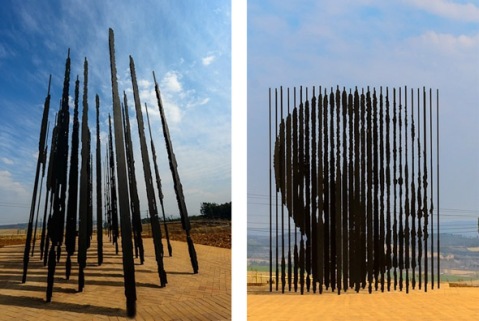
|
 August 5, 2012 -
Nelson Mandela Monument, Howick, KwaZulu-Natal (South Africa). At place where Mandela was arrested in 1962. "Dedicated exactly 50 years later. Created by Marco Cianfanelli. Made from 50 steel charcoal columns that create Mandela's head when viewed from a certain angle. 'The front of the sculpture is a portrait of Mandela, it has vertical bars which represent his imprisonment,' said Cianfanelli. 'When you walk through the structure it's radiates like a burst of light, which symbolises the political uprising of many people and solidarity.' The unveiling was attended by the current premier Jacob Zuma."
August 5, 2012 -
Nelson Mandela Monument, Howick, KwaZulu-Natal (South Africa). At place where Mandela was arrested in 1962. "Dedicated exactly 50 years later. Created by Marco Cianfanelli. Made from 50 steel charcoal columns that create Mandela's head when viewed from a certain angle. 'The front of the sculpture is a portrait of Mandela, it has vertical bars which represent his imprisonment,' said Cianfanelli. 'When you walk through the structure it's radiates like a burst of light, which symbolises the political uprising of many people and solidarity.' The unveiling was attended by the current premier Jacob Zuma."
|
 

|  September 25, 2012 - "Long Walk to Freedom," Johan de Wittlaan, International District, The Hague (Netherlands). Statue of Nelson Mandela by Arie Schippers. "Looks towards the Peace Palace. Stands more than twice life size...
Originally scheduled to be unveiled by the great man himself on Nelson Mandela Day July 18th [Mandela's birthday], the unveiling had to be postponed due to Nelson Mandela’s frail health. The statue was finally unveiled by Desmond Tutu on the 25th September 2012." /// Right image shows Bel Air Hotel & Organization for the Prohibition of Chemical Weapons (OPCW) in background.
Comment: On 4 September 2013, I walked over to shake Mandela's hand. Here's another monument with a problem. Not a single word of explanation. WHO is this guy, and WHY plunk his stature in the middle of a Hague sidewalk/footpath? /// N.B.: "Long Walk to Freedom" is title of Mandela's autobiography. September 25, 2012 - "Long Walk to Freedom," Johan de Wittlaan, International District, The Hague (Netherlands). Statue of Nelson Mandela by Arie Schippers. "Looks towards the Peace Palace. Stands more than twice life size...
Originally scheduled to be unveiled by the great man himself on Nelson Mandela Day July 18th [Mandela's birthday], the unveiling had to be postponed due to Nelson Mandela’s frail health. The statue was finally unveiled by Desmond Tutu on the 25th September 2012." /// Right image shows Bel Air Hotel & Organization for the Prohibition of Chemical Weapons (OPCW) in background.
Comment: On 4 September 2013, I walked over to shake Mandela's hand. Here's another monument with a problem. Not a single word of explanation. WHO is this guy, and WHY plunk his stature in the middle of a Hague sidewalk/footpath? /// N.B.: "Long Walk to Freedom" is title of Mandela's autobiography.  
|
2013:


 |  October 2, 2013 -
Nelson Mandela Square, Town Hall, Stellenbosch (South Africa). "The well-known Stellenbosch landscape artist Strijdom van der Merwe has just completed the town’s own Nelson Mandela Square in front of the town hall.
It was unveiled by Mr Martin Smuts, the town’s executive deputy mayor, on 2 October. Dr Ivan Meyer, provincial minister of cultural affairs & sport was the guest speaker." October 2, 2013 -
Nelson Mandela Square, Town Hall, Stellenbosch (South Africa). "The well-known Stellenbosch landscape artist Strijdom van der Merwe has just completed the town’s own Nelson Mandela Square in front of the town hall.
It was unveiled by Mr Martin Smuts, the town’s executive deputy mayor, on 2 October. Dr Ivan Meyer, provincial minister of cultural affairs & sport was the guest speaker."
|


 |  November 18, 2013 -
Nelson Mandela Centre of Memory, Nelson Mandela Foundation, 107 Central Street, Houghton, near Johannesburg (South Africa). on 18 November, 2013, in Johannesburg. "The centre holds a collection of books and personal items belonging to former president Nelson Mandela. It also has an area from which visitors can view his former Houghton office." Open by appointment only. Left image is artist's impression. November 18, 2013 -
Nelson Mandela Centre of Memory, Nelson Mandela Foundation, 107 Central Street, Houghton, near Johannesburg (South Africa). on 18 November, 2013, in Johannesburg. "The centre holds a collection of books and personal items belonging to former president Nelson Mandela. It also has an area from which visitors can view his former Houghton office." Open by appointment only. Left image is artist's impression. 
|
 

|  December 1, 2013 - Plaque for 175th Anniversary of Emancipation, Saron Mission Church, Saron (South Africa).
"Commemorates the 175th anniversary of the emancipation of slaves in the Cape Colony. Located next to the pulpit of the Mission Church. Unveiled during a commemorative service held in the church. Text on the plaque is in Afrikaans and reads: 'In memory of colonial slaves who were emancipated on 1 December 1838 and later became part of this congregation. Unveiled 1 December 2013.'" December 1, 2013 - Plaque for 175th Anniversary of Emancipation, Saron Mission Church, Saron (South Africa).
"Commemorates the 175th anniversary of the emancipation of slaves in the Cape Colony. Located next to the pulpit of the Mission Church. Unveiled during a commemorative service held in the church. Text on the plaque is in Afrikaans and reads: 'In memory of colonial slaves who were emancipated on 1 December 1838 and later became part of this congregation. Unveiled 1 December 2013.'"
|
 December 5, 2013 - Death of Nelson Mandela in Johannesburg.
December 5, 2013 - Death of Nelson Mandela in Johannesburg.

|
 December 15, 2013 - Grave of Nelson Mandela , Qunu, Eastern Cape Province (South Africa). "The body of former President Nelson Rolihlahla Mandela [1918-2013] was flown from Pretoria, where he had lain in state for three days, to this city in his native Eastern Cape Province on Saturday in preparation for a state funeral and burial to be held on Sunday." /// "Mthatha is the home of one of the three Nelson Mandela Museums [11 February 2000]: Spread across three sites, it collects, interprets & exhibits key aspects of the story of the life & times of Nelson Mandela in context. The three historical sites of the museum are all in the locality at Mvezo, Qunu & the Bunga Building in Mthatha itself. In the Bunga Building is the story of the "Long Walk to Freedom" and an exhibition of the many gifts received by Nelson Mandela on behalf of the South African people." /// "On 2 March 2004 Umtata was officially renamed to its current name Mthatha"
December 15, 2013 - Grave of Nelson Mandela , Qunu, Eastern Cape Province (South Africa). "The body of former President Nelson Rolihlahla Mandela [1918-2013] was flown from Pretoria, where he had lain in state for three days, to this city in his native Eastern Cape Province on Saturday in preparation for a state funeral and burial to be held on Sunday." /// "Mthatha is the home of one of the three Nelson Mandela Museums [11 February 2000]: Spread across three sites, it collects, interprets & exhibits key aspects of the story of the life & times of Nelson Mandela in context. The three historical sites of the museum are all in the locality at Mvezo, Qunu & the Bunga Building in Mthatha itself. In the Bunga Building is the story of the "Long Walk to Freedom" and an exhibition of the many gifts received by Nelson Mandela on behalf of the South African people." /// "On 2 March 2004 Umtata was officially renamed to its current name Mthatha" 
|

|  December 16, 2013 - Statue of Nelson Mandela, Union Buildings, Pretoria (South Africa). The R8 million bronze-plated statue was created by South African sculptors Andre Prinsloo & Ruhan Janse van Vuuren. It is close to the Union Buildings' lawns, overlooking Arcadia. /// "South Africa President Jacob Zuma yesterday unveiled a nine-metre statue of former president Nelson Mandela at the Union Buildings in Pretoria, as part of the Reconciliation Day celebrations. “We are happy that we are here. You will notice that in all the statues that have been made of Madiba, he is raising his fist and at times stretching it. That derives from the slogan of the ANC (African National Congress),” Zuma said.
The statue depicts Mandela smiling with his arms stretched outwards.
“This one (statute is different from many. He is stretching out his hands. He is embracing the whole nation. You shouldn’t say this is not Madiba because we know him with his one (raised) hand. “
The bronze colossus was unveiled at the Union Buildings, where Mandela was inaugurated as South Africa’s first black president in 1994.
The unveiling also marked the centenary celebrations of the Union Building. The statute recognises the contributions Mandela made to the country in fighting the repressive apartheid regime.
The Union Buildings was also where Mandela lied in state for three days during which about 100,000 people from all walks of life converged and paid their last respects. December 16, 2013 - Statue of Nelson Mandela, Union Buildings, Pretoria (South Africa). The R8 million bronze-plated statue was created by South African sculptors Andre Prinsloo & Ruhan Janse van Vuuren. It is close to the Union Buildings' lawns, overlooking Arcadia. /// "South Africa President Jacob Zuma yesterday unveiled a nine-metre statue of former president Nelson Mandela at the Union Buildings in Pretoria, as part of the Reconciliation Day celebrations. “We are happy that we are here. You will notice that in all the statues that have been made of Madiba, he is raising his fist and at times stretching it. That derives from the slogan of the ANC (African National Congress),” Zuma said.
The statue depicts Mandela smiling with his arms stretched outwards.
“This one (statute is different from many. He is stretching out his hands. He is embracing the whole nation. You shouldn’t say this is not Madiba because we know him with his one (raised) hand. “
The bronze colossus was unveiled at the Union Buildings, where Mandela was inaugurated as South Africa’s first black president in 1994.
The unveiling also marked the centenary celebrations of the Union Building. The statute recognises the contributions Mandela made to the country in fighting the repressive apartheid regime.
The Union Buildings was also where Mandela lied in state for three days during which about 100,000 people from all walks of life converged and paid their last respects.
|
2014:
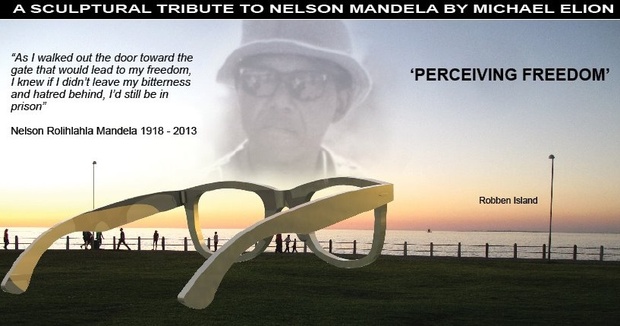 |  November 6, 2014 - "Perceiving Freedom," Sea Point Promenade, Cape Town (South Africa). "Cape Town unveiled a new memorial for Nelson Mandela late last week, a welcomed gesture in a city still closely associated with South Africa's Apartheid era. Sadly, the city's canonization effort has left many disappointed. Mandela was a man of great substance; this latest memorial is anything but.
To honor the late South African president, local artist Michael Elion built a giant pair of stainless steel Ray-Ban Wayfarer sunglasses. The enormous pair of chic sunglasses are angled to peer over the Atlantic Ocean towards Robben Island, where Mandela served his nearly three-decade prison term. Titled Perceiving Freedom, Elion's project aimed to connect memorial visitors with Mandela's prison experience. '[I]t links us to the mind of a man whose incredible capacity to transcend enduring physical hardship, with unwavering mental fortitude and dignity, transformed the consciousness of an entire country,' he explained to a local newspaper. (Mandela was known for occasionally sporting a pair of aviator-style sunglasses, but not Ray-Ban-style shades. Elion included this photo in the invitation to the memorial's opening.)
I'm not buying it, and neither are many South Africans." November 6, 2014 - "Perceiving Freedom," Sea Point Promenade, Cape Town (South Africa). "Cape Town unveiled a new memorial for Nelson Mandela late last week, a welcomed gesture in a city still closely associated with South Africa's Apartheid era. Sadly, the city's canonization effort has left many disappointed. Mandela was a man of great substance; this latest memorial is anything but.
To honor the late South African president, local artist Michael Elion built a giant pair of stainless steel Ray-Ban Wayfarer sunglasses. The enormous pair of chic sunglasses are angled to peer over the Atlantic Ocean towards Robben Island, where Mandela served his nearly three-decade prison term. Titled Perceiving Freedom, Elion's project aimed to connect memorial visitors with Mandela's prison experience. '[I]t links us to the mind of a man whose incredible capacity to transcend enduring physical hardship, with unwavering mental fortitude and dignity, transformed the consciousness of an entire country,' he explained to a local newspaper. (Mandela was known for occasionally sporting a pair of aviator-style sunglasses, but not Ray-Ban-style shades. Elion included this photo in the invitation to the memorial's opening.)
I'm not buying it, and neither are many South Africans."
|
Future:
 
 |  Future - Desmond Tutu Peace Centre & Museum, Roggebaai, Cape Town (South Africa). Will include one of four World Peace Tables by George Nakashima [1905-1990] of New Hope, Pennsylvania (USA). Future - Desmond Tutu Peace Centre & Museum, Roggebaai, Cape Town (South Africa). Will include one of four World Peace Tables by George Nakashima [1905-1990] of New Hope, Pennsylvania (USA).  /// "The green open grassy area to the right in this pic is the site proposed for the Desmond Tutu Peace Centre. I'm not sure if the development is still going ahead, however there has been no news of it being cancelled either..." /// "The green open grassy area to the right in this pic is the site proposed for the Desmond Tutu Peace Centre. I'm not sure if the development is still going ahead, however there has been no news of it being cancelled either..." 
|
 |  Future - World Peace Table, Desmond Tutu Peace Centre & Museum, Roggebaai, Cape Town (South Africa). Fourth of four World Peace Tables by George Nakashima [1905-1990] of New Hope, Pennsylvania (USA). Also known as Sacred Peace Table. "Our first conversation with the Director of the Desmond Tutu Peace Centre in 2004, showed that the ideals & vision of the Centre & the Nakashima Foundation for Peace were a natural match. Both sides were excited by the possibility. From that time forward through letters & visits, we became closely acquainted with each other, the bonds grew stronger. The next [fourth] Sacred Peace Table would be housed at the Desmond Tutu Peace Centre." Future - World Peace Table, Desmond Tutu Peace Centre & Museum, Roggebaai, Cape Town (South Africa). Fourth of four World Peace Tables by George Nakashima [1905-1990] of New Hope, Pennsylvania (USA). Also known as Sacred Peace Table. "Our first conversation with the Director of the Desmond Tutu Peace Centre in 2004, showed that the ideals & vision of the Centre & the Nakashima Foundation for Peace were a natural match. Both sides were excited by the possibility. From that time forward through letters & visits, we became closely acquainted with each other, the bonds grew stronger. The next [fourth] Sacred Peace Table would be housed at the Desmond Tutu Peace Centre." 
|
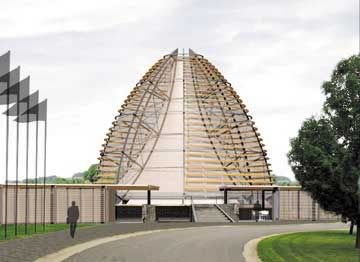
|  Future - Africa Peace Centre, somewhere in Africa. Planned by the African Centre for the Constructive Resolution of Disputes (ACCORD), Durban (South Africa). "A [$40 million] state-of-the-art complex which will act as a base for high level conflict intervention and continuous research and training. It will also incorporate a resource & documentation centre, a meeting and training centre, a conference venue, 80 guest residences and a number of VIP houses. The complex will also house the ACCORD offices." Future - Africa Peace Centre, somewhere in Africa. Planned by the African Centre for the Constructive Resolution of Disputes (ACCORD), Durban (South Africa). "A [$40 million] state-of-the-art complex which will act as a base for high level conflict intervention and continuous research and training. It will also incorporate a resource & documentation centre, a meeting and training centre, a conference venue, 80 guest residences and a number of VIP houses. The complex will also house the ACCORD offices."
|
"Taking the Nelson Mandela Route" by Claire Fulton
Tourists fascinated by South Africa's most beloved statesman, Nelson Mandela, can now "follow his footsteps" all the way from the Eastern Cape to Robben Island.
[1] The Nelson Mandela Route starts in the Eastern Cape, in King William's Town, which began as a London-based Missionary Station in 1826 and provides a backdrop to early European influences in a struggle region of British, Boer and Xhosa conflicts. The town's Amathole Museum has a Xhosa Gallery, Missionary Museum and German Settlers display. The grave of Black Consciousness leader Steve Biko is also in the town.
[2] The Mandela Route moves through Bhisho, home of the provincial government, and takes a scenic drive on the N2 to Mthatha, which hosts the Nelson Mandela Museum. The museum is a collection of heritage sectors spread across three locations: Qunu, Mveso and Mthatha. A display reflecting the life and times of Mandela can be found at the Bhunga Building section of the Nelson Mandela Museum in Mthatha. Mandela has received thousands of gifts from presidents, groups and ordinary people. Accepted on behalf of the people of South Africa, they are in safe-keeping at the museum for the benefit and appreciation of the nation. Artefacts ranging from children's letters to bejeweled camel covers say more about the donors than their famous recipient. Scenes from Mandela's childhood.
[3] The second sector of the museum is the Community Museum and Youth & Heritage Centre in the village of Qunu, where Mandela spent his childhood. Here, tourists can view the remains of young Nelson's primary school, the rock he used to slide down with friends, and the graveyard where his son, daughter and parents are buried – all set in the rolling hills of Pondoland, where Mandela grazed his family's cattle. Alongside the N2 is Mandela's current home, where he entertains a steady stream of people from the neighbouring village and holds an annual party for children on his birthday. A tunnel running under the N2 allows visitors to "cross" the road in safety.
[4] A thatched open-air museum at Mveso - the third sector of the Nelson Mandela Museum - shelters a photographic exhibition depicting significant moments in Mandela's life. Nearby are the remains of the homestead where Mandela was born and raised. Free guided tours of all three sectors of the Nelson Mandela Museum can be arranged via the museum in Mthatha.
[5] The Mandela Route then moves back to East London, which has a museum housing a superb collection of southern Nguni beadwork. Staying on the trail of the man himself, one has to leave the Eastern Cape, as he did.
[6] Mandela in Johannesburg. The Apartheid Museum in Johannesburg is a state-of-the-art tribute to the rise and fall of apartheid. Twenty-two exhibition areas take the visitor on an emotional journey through a state-sanctioned system based on racial discrimination. It was put together on a seven-hectare site by a team of curators, film-makers, historians, designers and architects. Film footage, photographs, text panels and artefacts depict the epic saga of apartheid.
[7] Mandela's humble house in Orlando West, Soweto has been turned into the Mandela Family Museum. It houses an assortment of memorabilia, paintings, photographs and collection of honorary doctorates bestowed on Mandela from universities around the world. This matchbox home at 8115 Ngakane Street was the abode that Mandela shared with his first wife, Evelyn Ntoko Mase. She moved out after their divorce in 1957, and when Winnie Madikizela married Mandela in 1958, she then moved into this Soweto home. Mandela seldom stayed here as he was living life on the run as the "black pimpernel."
[8] Nearby is the Hector Pieterson Memorial to the schoolboy shot during the June 16 riots of 1976, as well as the home of Nobel Peace laureate Desmond Tutu. Mandela's larger-than-life character and famous "Madiba jive" are also captured in an outsize 6 metre statue at the upmarket shopping destination Nelson Mandela Square (formerly Sandton Square) - a prime photo opportunity for tourists. This famous builder of bridges between people has also had the largest cable-stayed bridge in southern Africa named after him. It links the Johannesburg central business district of Newtown and the northern parts of the city.
[9] Robben Island. Finally - or firstly? - to Robben Island, off the coastline of Cape Town. The famous prison has incarcerated indigenous African leaders, Muslim leaders from the East Indies, Dutch and British settler soldiers and civilians, women and anti-apartheid activists, including South Africa's first democratic President, Nelson Rolihlahla Mandela. Today it is a museum which acts as a focal point for South African heritage. Ex-political prisoners act as tour guides in a place of exile and imprisonment which epitomises the triumph of the human spirit over adversity.
Article last updated: February 2008 This article was first published in Eastern Cape Madiba Action.
Please email your comments & questions to geovisual at comcast.net. Thank you.
Return to Peace Monuments main page.



1879 - Anglo-Zulu War.
1880-1881 - First Boer War (between British & Orange Free State + Transvaal Republic).
1899-1902 - Second Boer War (between British & Orange Free State + Transvaal Republic).




May 31, 1910 - The Union of South Africa becomes independent but remains in the
Commonwealth.




July 18, 1918 - Birth of Nelson Mandela in Mvezo, Cape Province.






- N.B.: "The southernmost town in Eastern Free State is named Hobhouse, after Emily Hobhouse, as was a submarine: the SAS Emily Hobhouse, one of the South African Navy's three Daphné class submarines. In 1994, after the end of minority rule, the submarine was renamed the SAS Umkhonto."




1948 - Apartheid system created after general election.

June 26, 1955 - Freedom Charter, Congress of the People, Kliptown, Soweto.


March 21, 1960 - Sharpville Massacre.


May 31, 1961 - South Africa becomes a Republic following a referendum.



August 5, 1962 - Police capture Nelson Mandela leading to his trial & emprisonment on Robben Island.

1963-1964 - Rivonia Treason Trial.







1972- US sanctions are imposed against South Africa (strengthened in 1986).

June 16, 1976 - Soweto Uprising.






February 2, 1990 - Nelson Mandela is released from prison.
July 1991 - US sanctions against South Africa are repealed.





April 27, 1994 - End of Apartheid. Celebratred as Freedom Day.
September 1994 - Bloemfontein (South Africa). "With the passions of centuries, the purging ritual that comes with revolution has begun in South Africa.
The statue of Hendrik Verwoerd [1901-1966], the father of apartheid, was yanked from its pedestal in the Afrikaner stronghold of Bloemfontein this month, and the black victims of a hated Government began eyeing the paintings of wigged lawmakers on Parliament walls and the busts of prime ministers that may be the next to go.
Just as the Berlin wall and statues of Lenin came down in recent years, the statue of the Prime Minister who drew the map of segregation and imposed inferior education on blacks, was wrested from his place in front of the provincial offices of the Orange Free State during a Friday afternoon rush hour..."








































June 27, 2006 - Africa Peace Award (APA), Durban (South Africa). Annual Africa Peace Award (APA) awarded to Burundi by the African Centre for the Constructive Resolution of Disputes (ACCORD). Which numbrer is this? Some other awards: Nelson Mandela (1995), Sierra Leone (2010), Ghana (2012), President Goodluck Jonathan of Nigeria (2013). /// N.B.: ACCORD intends to construct a $40 million Africa Peace Centre somewhere on the continent."








.jpg)








June 11-July 11, 2010 - World Cup in South Africa (first time in Africa).












December 5, 2013 - Death of Nelson Mandela in Johannesburg.







